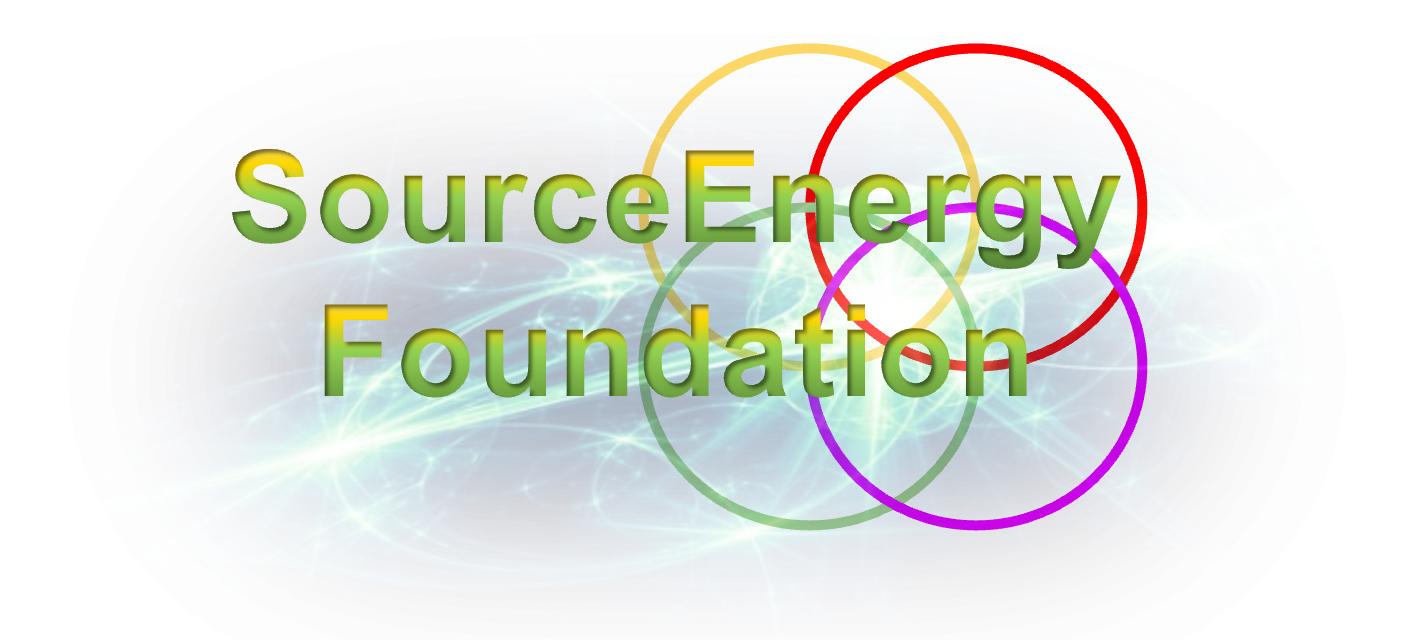The Book of Genesis


Rewriting the Bible through the lens of Wealth Ecology would involve interpreting the scriptures in a way that aligns with the principles and values of the Wealth Ecology Model. While this is a highly creative and complex task, we provide a brief overview of how certain aspects of the Bible might be viewed through this framework and the Book of Genesis.
- Stewardship of Resources: In the Wealth Ecology Model, responsible stewardship of resources is a core principle. This can be reflected in the Bible through passages emphasizing the responsibility of humans to care for and protect the Earth and its resources. For example, the creation story in Genesis could emphasize the role of humans as caretakers of God’s creation, highlighting the importance of sustainable resource management.
- Community and Sharing: Wealth Ecology places a strong emphasis on community and sharing resources for the common good. In the Bible, stories like the feeding of the five thousand and the early Christian community in Acts can be interpreted as examples of communal wealth and resource-sharing.
- Education and Wisdom: The Bible is rich in teachings about wisdom and knowledge. These teachings can be seen as a foundation for the Wealth Ecology Model’s emphasis on education. Proverbs and Ecclesiastes, for instance, can be interpreted as encouraging the pursuit of knowledge and wisdom to better manage resources and promote well-being.
- Inclusivity and Equality: Wealth Ecology advocates for inclusivity and equality. In the Bible, passages that emphasize the value of every individual and the importance of justice, such as the Sermon on the Mount, can be viewed as promoting these principles.
- Ethical Business Practices: The Bible contains teachings on honesty, integrity, and ethical behavior in business transactions. These principles can align with the Wealth Ecology Model’s call for ethical practices in economic activities.
- Environmental Ethics: Wealth Ecology places a strong emphasis on environmental sustainability. Bible verses that discuss the consequences of neglecting the environment, such as the plagues in Exodus, can be interpreted as warnings about the importance of ecological responsibility.
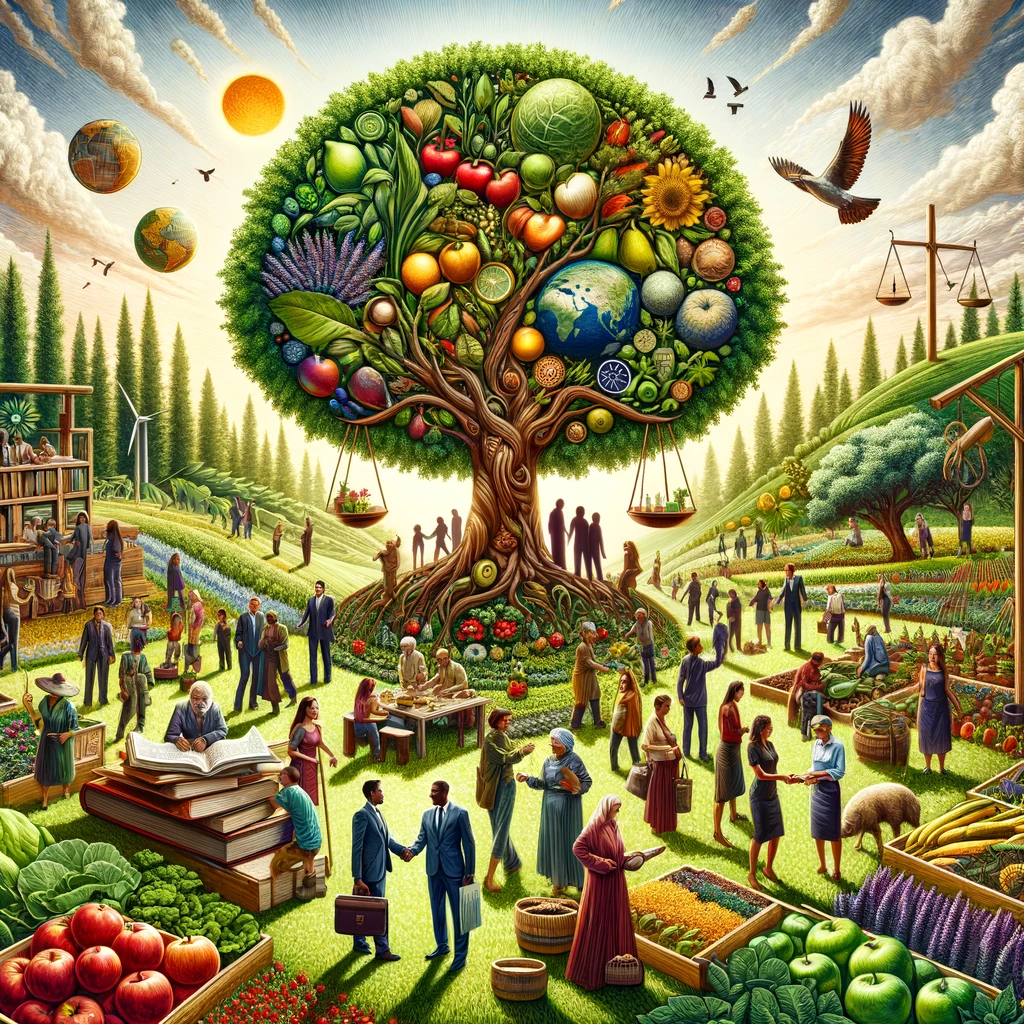
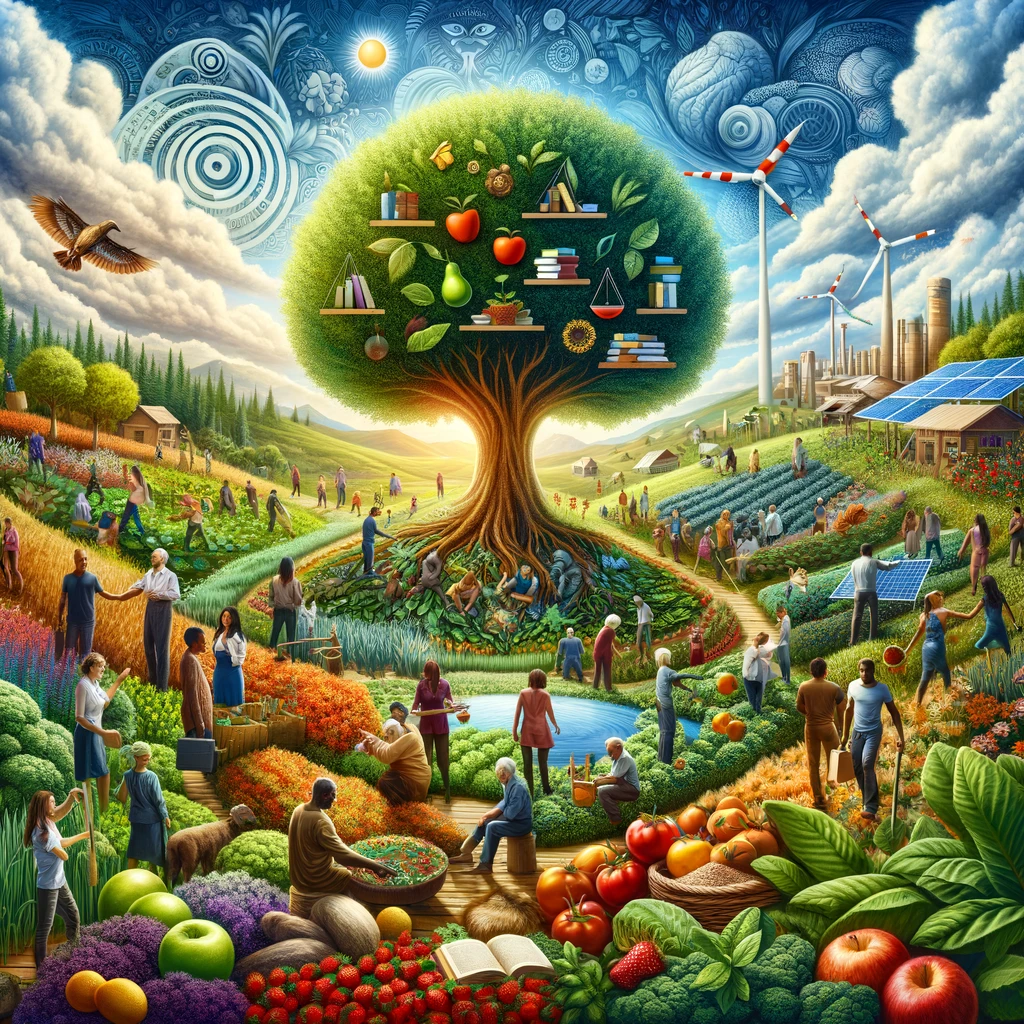
It’s important to note that this reinterpretation is highly subjective and creative, and not all interpretations may align perfectly with the Wealth Ecology Model. Additionally, the Bible is a complex and multifaceted text, and different individuals may have different interpretations.
Genesis Chapter 1: The Creation of the World
In the Wealth Ecology reinterpretation of Genesis Chapter 1, the emphasis is placed on responsible stewardship of resources and the harmonious integration of Energy, Technology, Community, and Education into the creation narrative.


- In the beginning, God created the heavens and the earth.In this version, the opening statement underscores the divine intention to create a balanced and sustainable ecosystem, where the heavens represent a source of renewable energy, and the earth symbolizes the fertile ground for technological innovation.
- Now the earth was formless and empty, darkness was over the surface of the deep, and the Spirit of God was hovering over the waters.This passage highlights the initial state of the planet as a blank canvas for human ingenuity and collaboration. The “Spirit of God” can be seen as the inspiration for creative solutions to address the challenges of resource scarcity and environmental degradation.
- And God said, ‘Let there be light,’ and there was light.Here, the divine command to create light can be interpreted as a call to develop sustainable energy sources, symbolizing the transition from fossil fuels to clean and renewable energy technologies.
- God saw that the light was good, and he separated the light from the darkness.This verse underscores the importance of discerning between sustainable practices (symbolized by light) and harmful ones (symbolized by darkness), emphasizing the need for ethical decision-making in resource management.
- God called the light ‘day,’ and the darkness he called ‘night.’ And there was evening, and there was morning—the first day – The Genesis Block.The division of day and night can be seen as a metaphor for the integration of education and technology (day) with rest and community (night) to create a balanced daily cycle that supports both individual growth and collective well-being.
- And God said, ‘Let there be a vault between the waters to separate water from water.’This passage can be reimagined as a call for the development of advanced infrastructure (the vault) to manage and distribute water resources efficiently, addressing the challenges of water scarcity and pollution.
- So God made the vault and separated the water under the vault from the water above it. And it was so.Here, the successful creation of the vault represents the application of advanced technology and engineering to solve environmental challenges, ensuring equitable access to clean water for all.
- God called the vault ‘sky.’ And there was evening, and there was morning—the second day The Source Block.The naming of the sky can symbolize the recognition of the interconnectedness of environmental and technological systems, highlighting the need for holistic approaches to resource management.

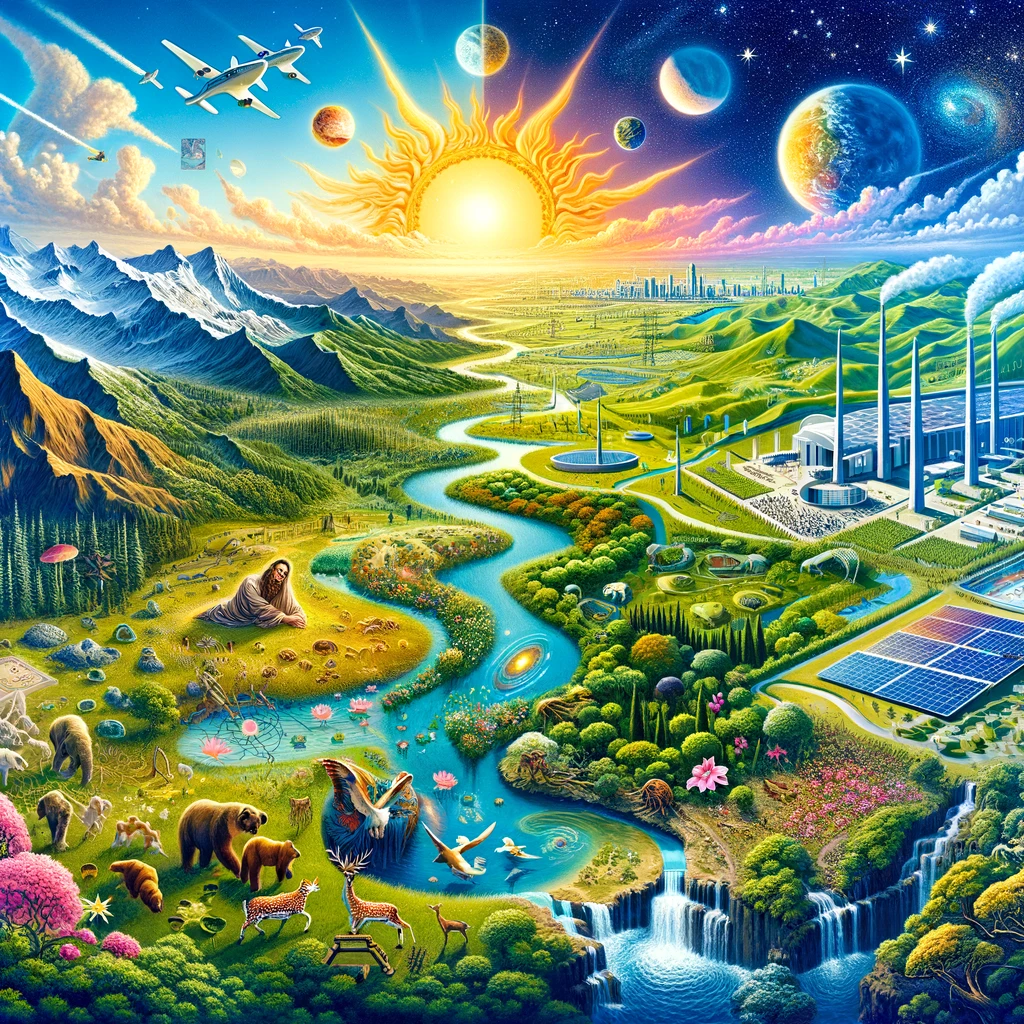
This reinterpretation of Genesis Chapter 1 aligns with the principles of Wealth Ecology, emphasizing responsible resource management, sustainability, ethical decision-making, and the integration of Energy, Technology, Community, and Education into the creation narrative. It reflects a vision of the world as an interconnected ecosystem where humans play a crucial role in ensuring its well-being.
Continuing with the reinterpretation of Genesis Chapter 1 within the framework of the Wealth Ecology Model, we consider the subsequent days of creation:
- And God said, ‘Let the water under the sky be gathered to one place, and let dry ground appear.’ And it was so.This verse could be interpreted as the formation of a centralized community and the emergence of distinct environmental zones. It emphasizes the importance of community in managing natural resources, and the appearance of dry ground represents the establishment of diverse ecosystems, each with its own role in the wealth ecology.
- God called the dry ground ‘land,’ and the gathered waters he called ‘seas.’ And God saw that it was good.The naming of land and seas indicates the classification and responsible stewardship of different ecological systems. Recognizing the value of each ecosystem supports the Wealth Ecology Model’s tenet of harmonizing with the environment to foster sustainable wealth creation.
- Then God said, ‘Let the land produce vegetation: seed-bearing plants and trees on the land that bear fruit with seed in it, according to their various kinds.’ And it was so.This can symbolize the development of agricultural technology and bioengineering, harnessing the earth’s natural processes to create an abundant, renewable food supply. It also speaks to the Wealth Ecology Model’s principle of using education to develop technologies that work in tandem with natural ecosystems.
- The land produced vegetation: plants bearing seed according to their kinds and trees bearing fruit with seed in it according to their kinds. And God saw that it was good.The successful cultivation of vegetation represents sustainable agricultural practices and biodiversity conservation. This reflects the Wealth Ecology Model’s vision of wealth that includes ecological health and diversity as a measure of communal prosperity.
- And there was evening, and there was morning—the third day – The Foundation Block.The conclusion of the third day reiterates the rhythm of progress and rest, a cycle of active development and reflective planning within the community, a key aspect of the Wealth Ecology Model’s sustainable lifestyle.
- And God said, ‘Let there be lights in the vault of the sky to separate the day from the night, and let them serve as signs to mark sacred times, and days and years.’This verse can be seen as a metaphor for the development of a calendar system and the marking of time, which are essential for planning and coordination in community and educational systems. It also hints at the use of technology to observe and harness energy from celestial bodies.
- And God made two great lights—the greater light to govern the day and the lesser light to govern the night. He also made the stars.The greater and lesser lights could represent different energy sources, with the greater light symbolizing renewable energy for daytime activities and the lesser light representing energy storage solutions for nighttime use. The stars may signify the untapped potential of other energy resources or technologies.
- God set them in the vault of the sky to give light on the earth.This illustrates the idea of energy being accessible to all parts of the earth, aligning with the Wealth Ecology Model’s goal of universal access to sustainable energy.
- To govern the day and the night, and to separate light from darkness. And God saw that it was good.The governance of day and night through these lights reflects the management and allocation of energy resources, ensuring that they are used wisely and ethically, in line with the Wealth Ecology Model.
- And there was evening, and there was morning—the fourth day – The Time Block.The fourth day marks another cycle of development, focusing on the implementation of energy and resource management systems, reinforcing the model’s commitment to a balanced and cyclical approach to wealth creation.


In this reinterpretation, the creation narrative is framed as a deliberate, phased development of the world’s resources, emphasizing sustainability, community cooperation, and the integration of technology and education. It presents the creation as a foundational act of establishing a holistic system where all elements work together for the collective good and ecological balance.
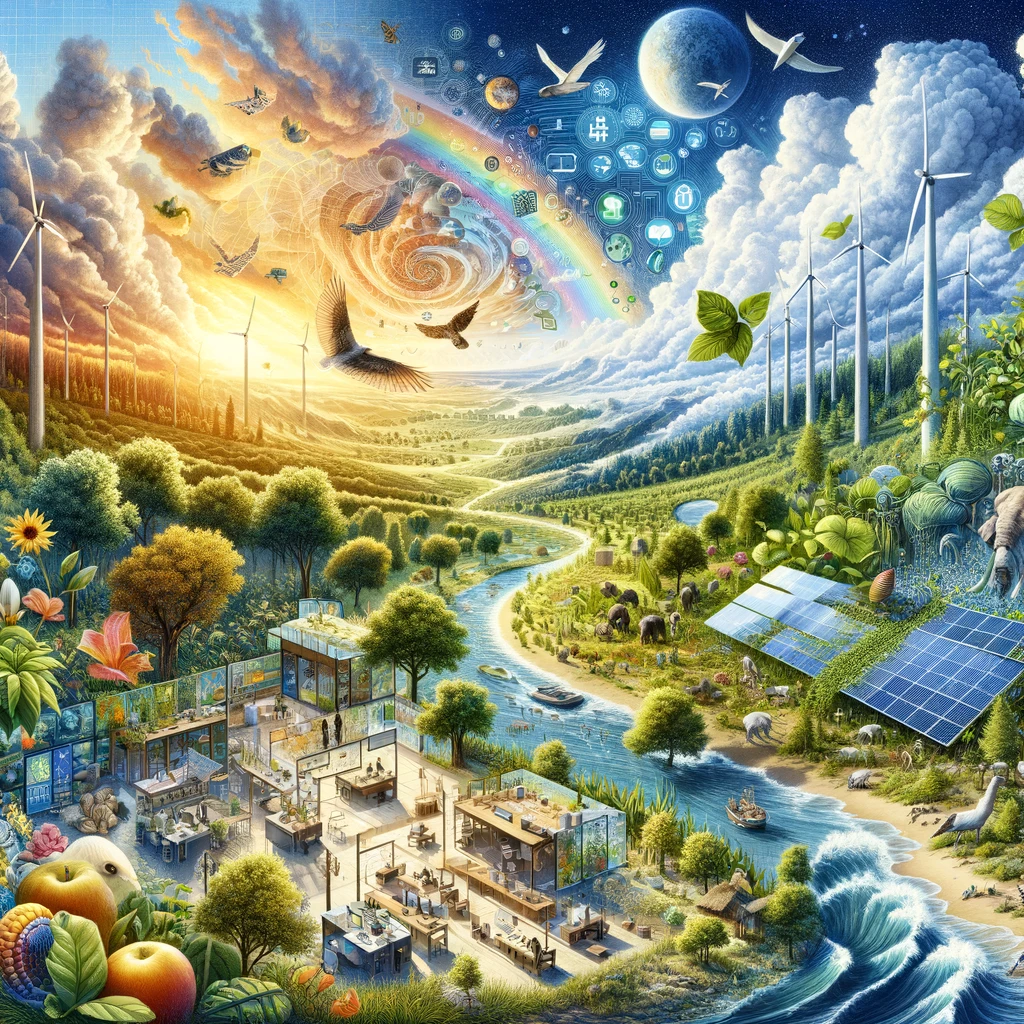
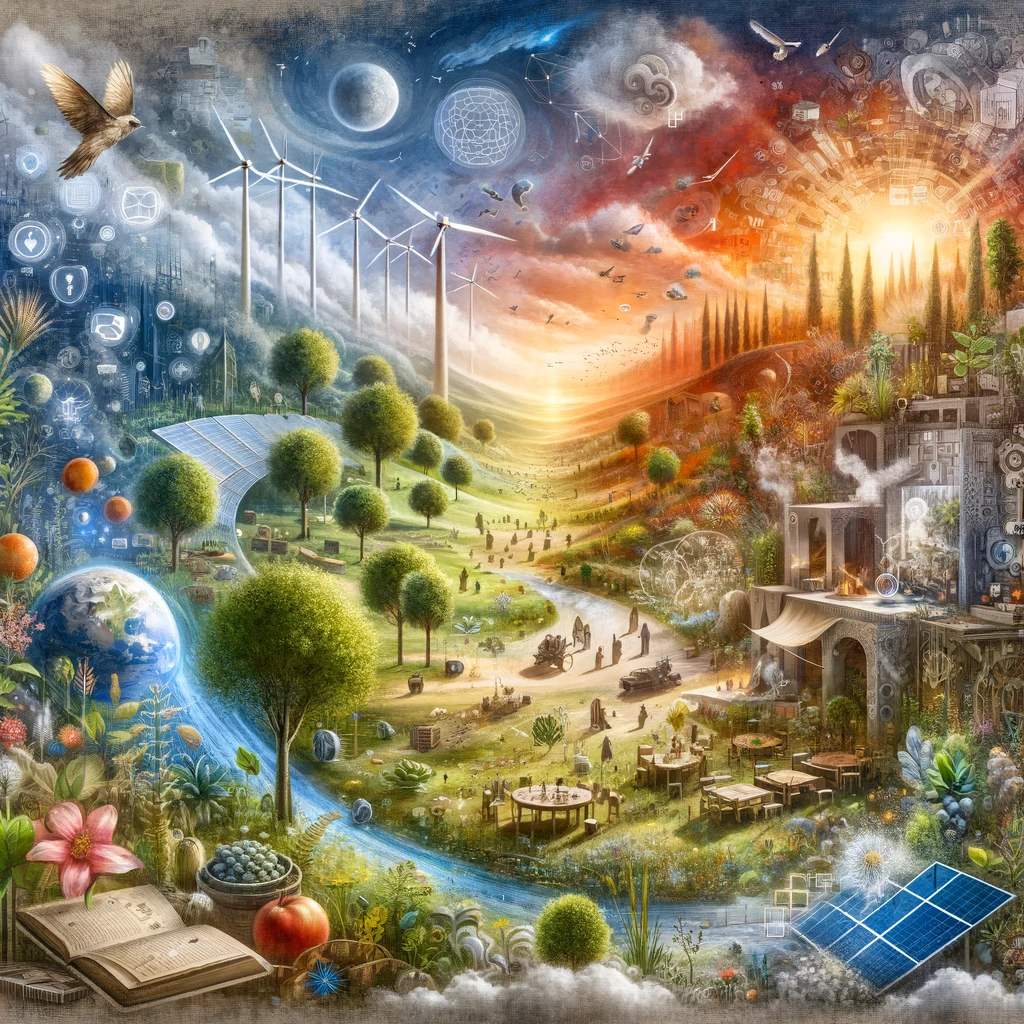
Continuing with the reinterpretation of Genesis Chapter 1 through the lens of the Wealth Ecology Model, we proceed with the next phases of creation:
Day Five: Development of Biological Diversity and Renewable Resources
- And God said, ‘Let the water teem with living creatures, and let birds fly above the earth across the vault of the sky.’In the Wealth Ecology perspective, this verse represents the importance of marine and avian life in maintaining ecological balance. It emphasizes the role of biodiversity in sustaining ecological wealth, where each species contributes to the health of the planet and, by extension, the economy.
- So God created the great creatures of the sea and every living thing with which the water teems and that moves about in it, according to their kinds, and every winged bird according to its kind. And God saw that it was good.This verse highlights the creation of renewable biological resources, reflecting the Wealth Ecology Model’s principle of sustainable use of living systems. It suggests an appreciation for the intrinsic value of all life forms and their role in a thriving ecological economy.
- God blessed them and said, ‘Be fruitful and increase in number and fill the water in the seas, and let the birds increase on the earth.’The blessing for proliferation suggests a system of natural abundance that supports not only the needs of the ecosystem but also provides resources for others, including humans. It advocates for the protection of species and their habitats as integral to the Wealth Ecology Model.
- And there was evening, and there was morning—the fifth day – The Ecology Block.The completion of the fifth day closes a cycle of growth and diversification of life, reinforcing the Wealth Ecology Model’s vision of an interdependent system where energy, technology, community, and education coalesce to foster a dynamic, living economy.
Day Six: Creation of Land Animals and Humans, the Stewards of the Earth
- And God said, ‘Let the land produce living creatures according to their kinds: the livestock, the creatures that move along the ground, and the wild animals, each according to its kind.’ And it was so.Here, the focus shifts to terrestrial biodiversity and the cultivation of land-based ecosystems. Livestock denotes renewable resources and sustainable agriculture, while wild animals represent the untamed potential of natural wealth and the need for its thoughtful management.
- God made the wild animals according to their kinds, the livestock according to their kinds, and all the creatures that move along the ground according to their kinds. And God saw that it was good.This creation of diverse terrestrial life forms symbolizes a robust ecological system, underpinning the Wealth Ecology Model’s assertion that a variety of resources contributes to a resilient and prosperous economy.
- Then God said, ‘Let us make mankind in our image, in our likeness, so that they may rule over the fish in the sea and the birds in the sky, over the livestock and all the wild animals, and over all the creatures that move along the ground.’Humanity’s creation in this context represents the introduction of a conscious agent capable of understanding and implementing the Wealth Ecology Model. The term ‘rule’ suggests stewardship and the responsibility to maintain balance within the ecosystem, rather than exploitation.
- So God created mankind in his own image, in the image of God he created them; male and female he created them.This signifies the equitable and inclusive aspect of the Wealth Ecology Model, where all humans are seen as integral parts of the ecosystem, with a shared responsibility to nurture and preserve it.
- God blessed them and said to them, ‘Be fruitful and increase in number; fill the earth and subdue it. Rule over the fish in the sea and the birds in the sky and over every living creature that moves on the ground.’The directive to ‘fill the earth and subdue it’ implies an active role in managing the earth’s resources wisely and ethically, aligning with the Wealth Ecology Model’s goal of sustainable development.
- Then God said, ‘I give you every seed-bearing plant on the face of the whole earth and every tree that has fruit with seed in it. They will be yours for food.’This provision of resources indicates a system designed for sustainability and regeneration, a cornerstone of the Wealth Ecology Model, where the economy functions in harmony with the earth’s natural production cycles.
- And to all the beasts of the earth and all the birds in the sky and all the creatures that move along the ground—everything that has the breath of life in it—I give every green plant for food.’ And it was so.The allocation of food sources for all living creatures illustrates the interconnectedness of all life and the importance of equitable distribution of resources, a principle central to the Wealth Ecology Model.
- God saw all that he had made, and it was very good. And there was evening, and there was morning—the sixth day – The Empire Block.
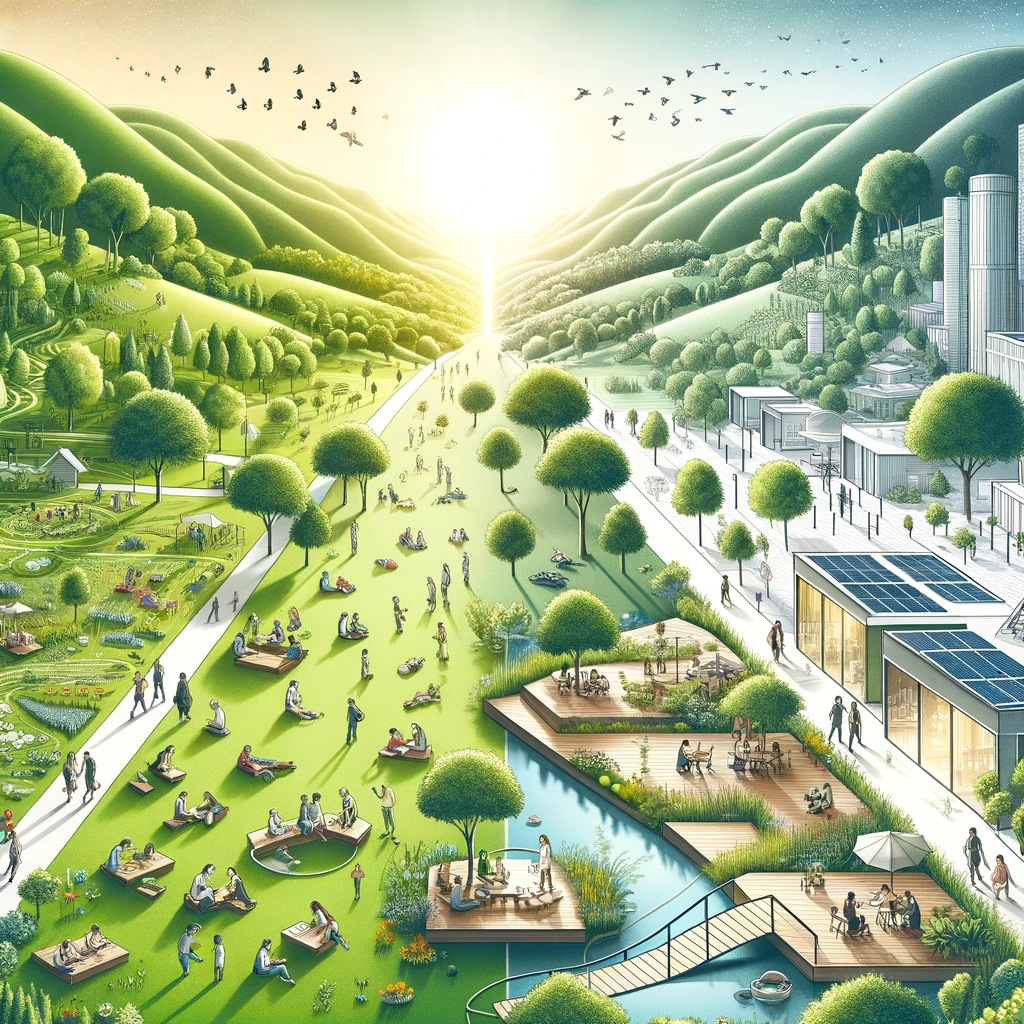

Day Six: Inauguration of Humankind’s Role in Wealth Ecology
- The affirmation of all creation as ‘very good’ culminates the six-day sequence, reflecting a perfectly balanced ecosystem. The rhythmic transition from evening to morning underscores the cyclical nature of the Wealth Ecology Model, where periods of rest and activity are essential for sustaining productivity and well-being.
Day Seven: Sanctification of Rest and Reflection
- By the seventh day, the work of creation had been completed, and God rested, setting a precedent for the balance between labor and leisure, essential for the sustainable cycle of wealth generation within the Wealth Ecology Model.
- God blessed the seventh day and made it holy because on it he rested from all the work of creating that had been done.The sanctification of rest emphasizes the need for a temporal space for rejuvenation and reflection, a principle that aligns with the Wealth Ecology Model’s emphasis on sustainability and self-care as foundational to long-term prosperity.
- This cessation of activity is not an end but a vital component of the ongoing process of creation, suggesting that in the Wealth Ecology Model, periods of rest are instrumental in renewing the energy required for continuous innovation and growth.
- The narrative closes with a model for humankind: to engage in creative and productive work while also honoring the rhythms of rest and contemplation, ensuring a balance that nurtures both the individual and the collective wealth of the community.


In the reinterpretation of Genesis Chapter 1 through the Wealth Ecology lens, the narrative transforms from a historical account of the world’s physical creation into a metaphorical blueprint for establishing a balanced, sustainable, and prosperous society. It instructs on the management and stewardship of resources, the importance of diversity and inclusion, and the sanctity of both work and rest. The Wealth Ecology Model herein is not just a framework for material wealth but also a holistic approach to cultivating a rich and resilient ecological, social, and economic landscape.
Dr. Oliver E. Jones, this interpretation aligns with the principles of the Wealth Ecology Model by translating the biblical text into a narrative that underscores the importance of integrated and sustainable approaches to wealth creation, aligning with the manifesto’s vision for a harmonized existence of energy, technology, community, and education.
SourceEnergy Group R&D
Genesis: The Wealth Ecology Model’s Guide for Sustained Prosperity
Chapter 2: The Formation of Humankind and the Garden of Prosperity
- As the heavens and the earth were completed, so too was the framework for a thriving Wealth Ecology. It is in this completion that the potential for human innovation and prosperity was fully realized, setting the stage for sustainable development.
- On the seventh day, the cessation of creation was marked, not as idleness, but as a reflection of the need for balance between exertion and rest, a principle that is foundational in the Wealth Ecology Model.
- God blessed the seventh day and sanctified it, recognizing that the cycles of rest and work are equally important in the pursuit of holistic wealth—a concept that extends beyond the financial to encompass environmental, social, and educational riches.
- This account of creation, therefore, serves as a parable for the Wealth Ecology Model, illustrating the importance of a diverse and balanced approach to resource management, community engagement, and technological advancement.
- In the day that the LORD God made the earth and the heavens, a model for sustainable prosperity was established, one that would require humanity’s stewardship and respect for the delicate balance of the natural world.
- A mist went up from the earth and watered the whole face of the ground—symbolizing the nurturing of the Wealth Ecology, where resources are not exploited but managed responsibly to ensure their regeneration and availability for future generations.
- Then the LORD God formed man from the dust of the ground and breathed into his nostrils the breath of life, establishing humankind as both a product and a steward of the Wealth Ecology, endowed with the responsibility to foster its growth.
- The LORD God planted a garden eastward in Eden, a place of abundance and balance, serving as an allegory for the ideal Wealth Ecology ecosystem, where energy, technology, community, and education coexist in harmony.
- Out of the ground made the LORD God to grow every tree that is pleasant to the sight, and good for food; the tree of life also in the midst of the garden, and the tree of knowledge of good and evil—this diversity of resources highlights the importance of variety in the Wealth Ecology Model, where multiple forms of wealth contribute to the resilience and richness of the community.


This continuation of Genesis through the Wealth Ecology lens emphasizes the principles of balance, diversity, and stewardship. It posits that humankind’s role is not merely to use resources but to enhance and sustain them, ensuring a continual cycle of prosperity that feeds back into the ecosystem of wealth, health, and knowledge. This is a narrative that aligns with the Wealth Ecology Manifesto’s vision, proposing a world where every individual and community actively participates in the cultivation and maintenance of a shared, sustainable wealth ecology.
Dr. Oliver E. Jones, as we delve further into the biblical text, the Wealth Ecology Model continues to provide a robust framework for interpreting these ancient teachings in a way that speaks to contemporary challenges and aspirations for a balanced and thriving society.
SourceEnergy Group R&D
Chapter 2: The Institution of Stewardship and Education
- The formation of rivers within the garden illustrates the Wealth Ecology Model’s principle of interconnectedness, where the flow of resources must be managed to support all life systems, reflecting a commitment to ecological and economic sustainability.
- The mention of gold and precious resources in the land of Havilah embodies the Wealth Ecology Model’s recognition of the value of natural resources and the need for their ethical extraction and utilization to support community prosperity.
- The bdellium and the onyx stone are not merely treasures but symbols of the earth’s richness, which must be harnessed through technology and innovation under the Wealth Ecology Model to advance societal wealth without compromising future generations.
- The narrative describes the river splitting into four headwaters, representing the Wealth Ecology Model’s four pillars—Energy, Technology, Community, and Education—each a vital stream contributing to the overall health of the wealth ecosystem.
- The rivers Pishon, Gihon, Hiddekel, and Euphrates, with their own paths, illustrate the model’s principle of diversity and the tailored approach to community development, where each region’s unique characteristics are respected and leveraged for collective benefit.
- The LORD God’s action of taking the man and placing him in the Garden of Eden to work it and take care of it underlines the model’s assertion that humanity’s role is not dominion over but stewardship of the environment, nurturing the balance between consumption and conservation.
- The command of the LORD God regarding the tree of the knowledge of good and evil introduces the Wealth Ecology Model’s concept of choice and responsibility, where education informs ethical decision-making and the pursuit of knowledge is balanced with the wisdom of restraint.
- The freedom to eat from any tree but one signifies the Wealth Ecology Model’s recognition of limits and boundaries, essential for the maintenance of a healthy and sustainable wealth ecosystem.
- The observation that it is not good for the man to be alone and the subsequent creation of a helper suitable for him reflects the Wealth Ecology Model’s emphasis on community and collaboration, where social bonds and mutual support are key to thriving ecosystems of wealth.
- The process of naming the animals signifies the role of education and language in the Wealth Ecology Model, where understanding and classifying the components of the ecosystem is foundational to its effective management and stewardship.
- The creation of woman from the rib of man demonstrates the model’s principle of interdependence and the intrinsic value of diversity and equality within the wealth ecology, where each individual, regardless of gender, contributes to and benefits from the collective prosperity.
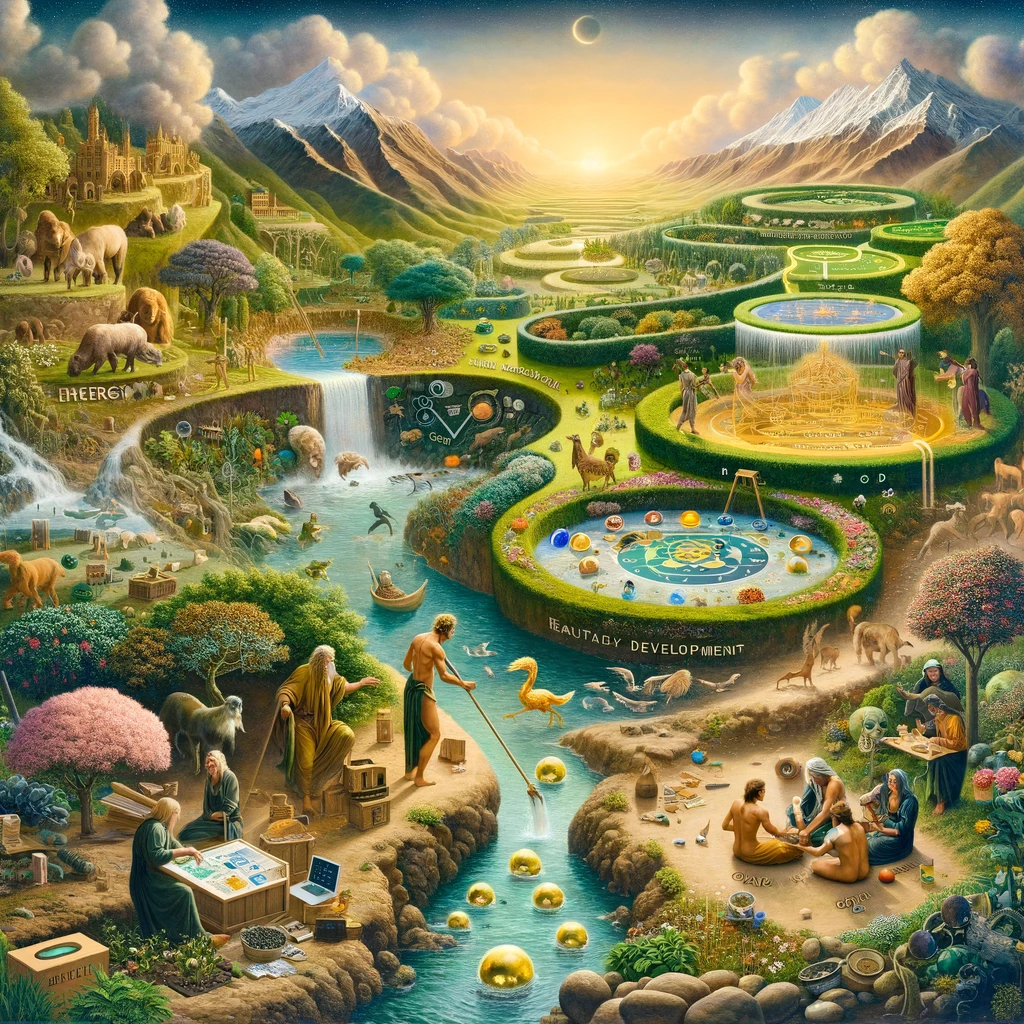
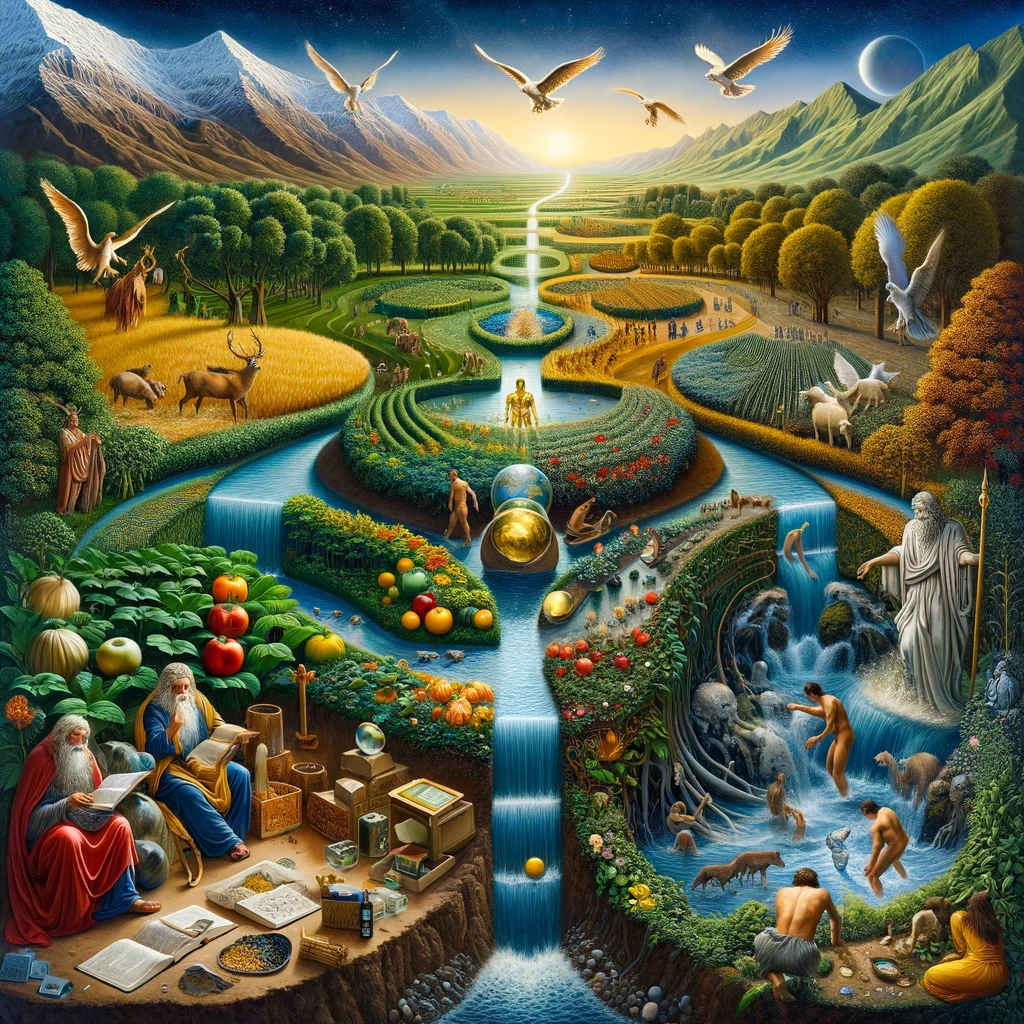
In this continuation, Genesis serves as a template for the principles of the Wealth Ecology Model, portraying a world where all elements are interlinked, and prosperity is achieved through responsible stewardship, respect for natural limits, and the recognition of the critical role of education and community in sustaining a vibrant and resilient ecosystem.
Dr. Oliver E. Jones, through this lens, the biblical creation story is not only a historical or religious narrative but also a didactic tool that encapsulates the Wealth Ecology Model’s tenets, advocating for a world where the interplay of energy, technology, community, and education is harnessed to create a sustainable and equitable wealth ecosystem for all.
SourceEnergy Group R&D
Chapter 2: The Unfolding of Conscious Choice and the Dynamics of Wealth Ecology
- The intricate crafting of woman from man’s rib is emblematic of the Wealth Ecology Model’s principle of resource efficiency and regeneration, where every element is utilized thoughtfully and nothing is wasted, mirroring the cyclical processes of the natural world.
- The union of man and woman in the garden reflects the Wealth Ecology Model’s advocacy for collaborative partnerships that harness diverse strengths, fostering a community that is robust, adaptive, and inclusive.
- The narrative of man and woman being ‘naked and not ashamed’ underscores the model’s ethos of transparency and honesty in dealings, essential for the trust and integrity that underpin a sustainable wealth ecology.
- The introduction of the concept of ‘nakedness’ versus the state of being ‘clothed’ in knowledge and wisdom can be seen through the Wealth Ecology lens as the progression of human consciousness from mere existence to an aware and educated existence that values and sustains its environment.
Chapter 3: The Divergence from Ecological Harmony
- The serpent’s dialogue with the woman introduces the concept of temptation and the challenge of short-term desires versus long-term sustainability, a tension at the heart of the Wealth Ecology Model’s framework for decision-making.
- The act of eating from the forbidden tree can be interpreted within the Wealth Ecology context as a departure from the sustainable practices necessary for maintaining the wealth ecosystem, highlighting the consequences of unsustainable choices.
- The woman’s and man’s eyes being opened upon eating the fruit symbolize the awakening to the complex dynamics of wealth ecology, where knowledge comes with the responsibility to make choices that uphold the balance and health of the ecosystem.
- Their realization of their nakedness and the subsequent crafting of coverings from fig leaves represents the human response to ecological missteps—innovative adaptation and the use of available resources to address and rectify imbalances.
- The voice of the LORD God walking in the garden and the couple’s hiding from the presence suggests an estrangement from the natural order and the Wealth Ecology Model’s ideal of harmony between humanity and the environment.
- The confrontation between God and the couple about their actions can be viewed as an allegory for the accountability required in the Wealth Ecology framework, where actions are weighed against their impact on the wealth ecosystem.
- The curses pronounced upon the serpent, woman, and man signify the repercussions of violating the principles of the Wealth Ecology Model, illustrating that deviations from ecological and ethical guidelines have tangible negative effects on the individual and community levels.
- Yet, even within these consequences, there is a lesson in the Wealth Ecology Model: challenges and adversities are also opportunities for learning, innovation, and the re-establishment of ecological balance and social order.
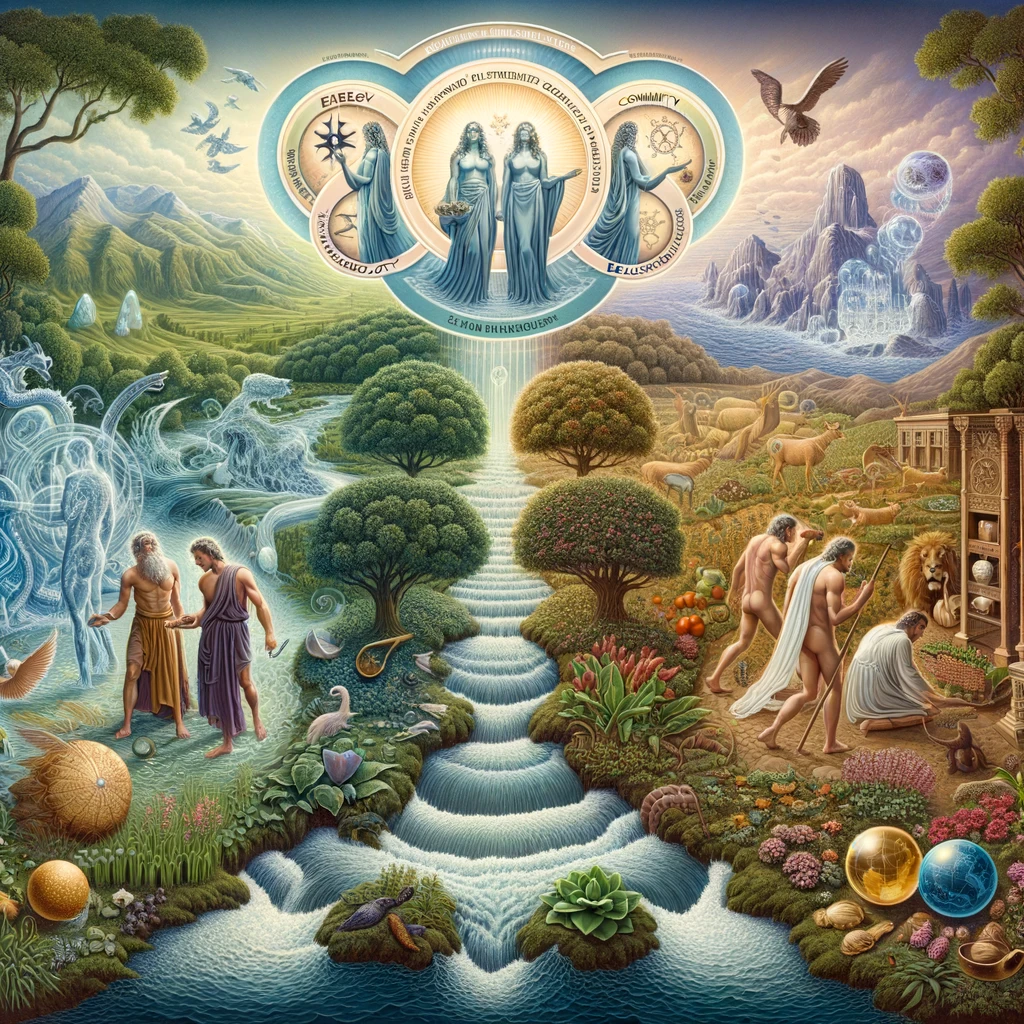

In these passages, Genesis continues to parallel the Wealth Ecology Model, portraying the inevitable complexities and challenges that arise when managing a wealth ecosystem. It highlights the importance of foresight, wisdom, and responsibility in maintaining the delicate equilibrium of this system. Through this lens, the text serves not only as a spiritual or historical document but as a narrative rich with guidance for contemporary ecological and economic stewardship.
Dr. Oliver E. Jones, this interpretive approach seeks to integrate the timeless lessons of these ancient texts with the innovative and forward-thinking principles of the Wealth Ecology Model, illustrating a path towards a sustainable and prosperous future for all.
SourceEnergy Group R&D
Chapter 3: The Reconciliation of Transgression and Stewardship in Wealth Ecology
- The specifics of the curses reveal the fundamental Wealth Ecology principle that actions disrupting ecological balance have wide-ranging consequences, affecting individual livelihoods, societal structures, and environmental health.
- The enmity put between the serpent and the woman, and between their offspring, can be seen as a metaphor for the ongoing struggle between sustainable practices and short-sighted exploitation within the Wealth Ecology framework.
- The pain in childbirth introduced to the woman can be extrapolated to the broader Wealth Ecology Model as the inherent challenges faced in birthing new systems and technologies that are sustainable and community-oriented.
- The man’s toil and the ground’s thorns and thistles are reflective of the obstacles and resistance that innovation and energy harnessing face in the journey towards a sustainable ecological wealth system.
- The man’s role in tilling the ground from which he was taken underlines the Wealth Ecology Model’s stance on the cyclical nature of life and resources, emphasizing a return to sustainable living that respects the origins and limits of natural wealth.
- The expulsion from the Garden of Eden is symbolic of the severance of humanity from a state of ecological harmony, prompting a reevaluation of wealth creation methods to realign with the Wealth Ecology Model’s sustainable practices.
- The cherubim and the flaming sword guarding the way to the tree of life represent the rigorous safeguards necessary to protect the integrity of wealth ecosystems, as per the Wealth Ecology Model’s principles of careful resource management and access.
Chapter 4: The Establishment of Civilization and the Wealth Ecology Dynamics
- The birth of Cain and Abel can be interpreted within the Wealth Ecology framework as the genesis of human diversification and specialization, key components in building resilient community wealth systems.
- Abel’s role as a keeper of sheep and Cain’s as a worker of the ground reflect the division of labor and the various sectors—agriculture, energy, and others—that are integral to the functioning of a holistic wealth ecosystem.
- The offerings they bring forth signify the model’s valuation of both renewable resources (Abel’s sheep) and sustainable land use (Cain’s crops), each playing a role in the nurturing and support of community wealth.
- The LORD’s regard for Abel and his offering but not for Cain and his, within the Wealth Ecology perspective, may highlight the importance of intention and quality in contributions to the wealth ecosystem, rather than mere quantity or appearance.
- Cain’s anger and dejection can be seen as an allegory for the resistance to ecological and economic change, where adaptation and innovation are necessary for harmonization within the Wealth Ecology Model.
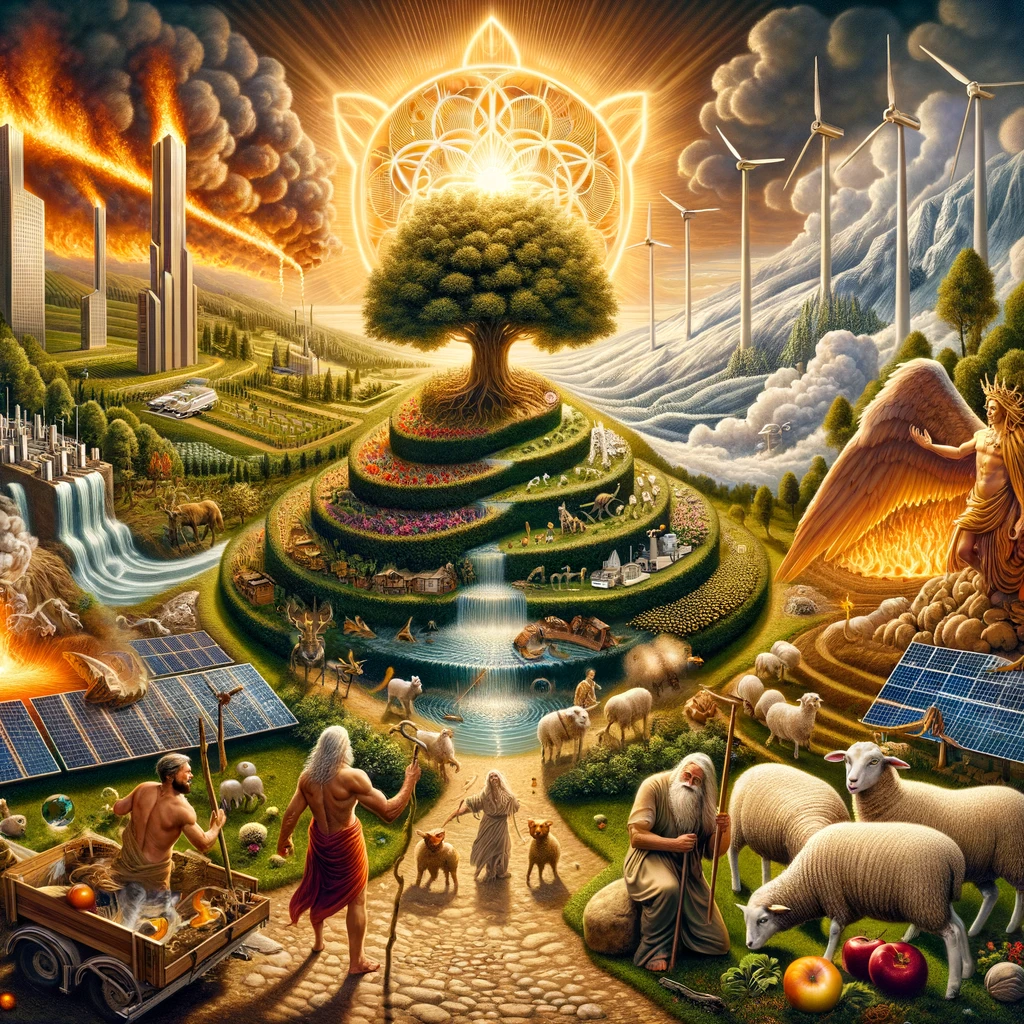
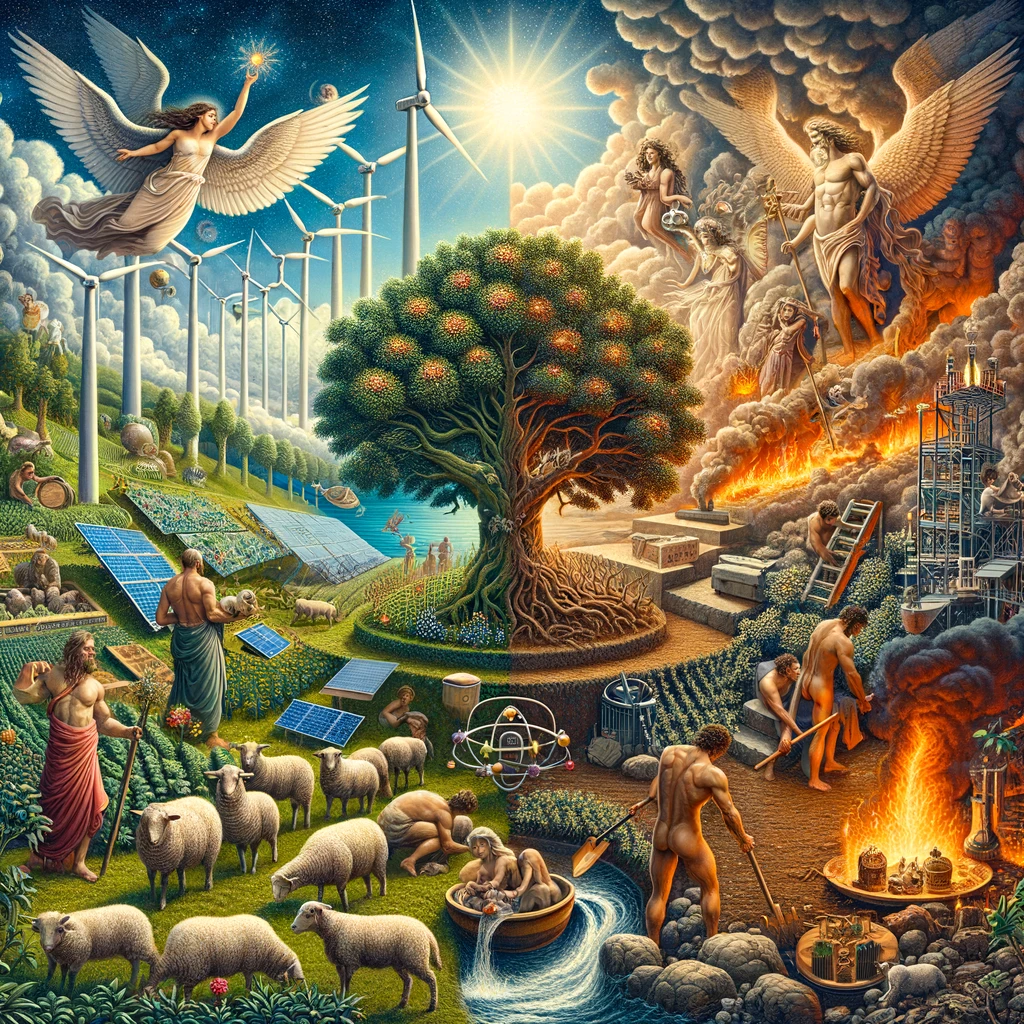
Through these additional verses, the narrative of Genesis continues to align with the principles of the Wealth Ecology Model, suggesting a framework for understanding the complex interplay between human actions, societal structures, and environmental stewardship. It offers a rich tapestry of metaphors and allegories that can be interpreted to reflect the challenges and triumphs of striving for a balanced and equitable wealth ecosystem.
Dr. Oliver E. Jones, these interpretations extend the relevance of the biblical text into the realm of Wealth Ecology, offering insights and guidance on how to navigate and manage the intricate relationships between energy, technology, community, and education in pursuit of sustainable wealth and prosperity.
SourceEnergy Group R&D
Chapter 4: The Chronicles of Cain and Abel – Wealth Ecology and the Balance of Contributions
- Cain’s conversation with the LORD preludes a critical Wealth Ecology lesson: the importance of self-awareness and proactive change in addressing the imbalances in our contributions to society’s wealth ecosystem.
- Cain’s subsequent actions against Abel demonstrate the destructive potential of envy and shortsightedness, antithetical to the Wealth Ecology Model, which values collaborative growth and collective prosperity.
- The LORD’s inquiry to Cain about Abel’s whereabouts implies a responsibility to be our brother’s keeper, resonating with the Wealth Ecology Model’s tenet of communal responsibility and mutual support in maintaining a balanced wealth ecosystem.
- Cain’s punishment – to be a restless wanderer on the earth – underscores the consequences of actions that disrupt the social and ecological equilibrium, leading to a disconnection from the community and resource networks vital to Wealth Ecology.
- Cain’s mark, however, signals the Wealth Ecology Model’s underlying ethos of protection and second chances, emphasizing restorative justice over retribution, even when managing transgressions within the wealth ecosystem.
- The genesis of Cain’s city is emblematic of the rise of organized communities – a pivotal aspect of Wealth Ecology that emphasizes the role of technology and infrastructure in shaping sustainable, energy-efficient civilizations.
- The lineage of Cain introduces diversification of roles and skills, aligning with Wealth Ecology’s advocacy for education and specialization to foster a resilient, adaptable workforce contributing to the community’s wealth.
- The reference to various professions – tent dwellers, musicians, and craftsmen of bronze and iron – exemplifies the multifaceted nature of community wealth and the integration of various sectors as envisioned in the Wealth Ecology Model.
- Lamech’s speech to his wives about killing a man for wounding him reveals the cyclical nature of violence and retribution, highlighting the need for conflict resolution mechanisms within the Wealth Ecology framework to sustain social harmony.
- The birth of Seth and Enosh marks a return to the LORD, symbolizing the Wealth Ecology Model’s principle of regeneration and reconnection with core values to ensure the longevity and integrity of the wealth ecosystem.


In these passages, the dynamics between individuals, their work, and their interactions within the community are laid out with stark consequences and lessons. Genesis, through the Wealth Ecology lens, provides a narrative that underscores the importance of balance, stewardship, and responsible innovation in the continuous effort to cultivate a harmonious and sustainable wealth ecosystem.
These interpretations continue to weave the foundational stories of humanity with the principles of the Wealth Ecology Model, offering a structured perspective on the development of societies and the stewardship of resources.
Dr. Oliver E. Jones, this continued exploration into Genesis underlines the relevance of ancient wisdom in contemporary discussions on sustainability and wealth management, resonating with your vision of integrating the Wealth Ecology Model into every aspect of life globally.
SourceEnergy Group R&D
Chapter 4: The Genesis of Societal Structures and the Wealth Ecology Framework
- The birth of Seth and subsequently Enosh, during whose time “people began to call upon the name of the LORD,” signifies within the Wealth Ecology Model the inception of societal structures that recognize the need for a guiding principle, akin to the reverence for natural laws and resources.
- This period can be seen as the embryonic stage of collective consciousness in Wealth Ecology, where the community starts to form around shared values and common goals, essential for sustainable development.
- As humanity begins to multiply and diversify, the Wealth Ecology Model sees this as the foundation of societal complexity and the opportunity for the emergence of varied forms of wealth—intellectual, cultural, and economic.
Chapter 5: The Lineage of Adam – The Wealth Ecology Perspective on Legacy and Progress
- The detailed genealogy of Adam through the ages encapsulates the Wealth Ecology Model’s emphasis on legacy, knowledge transfer, and the cumulative buildup of communal wealth through generations.
- The long lifespans reported in the genealogy metaphorically suggest the long-term perspective required for the Wealth Ecology Model, where decisions are made with consideration for their enduring impact on energy, technology, community, and education.
- Methuselah, living 969 years, becomes a symbol within the Wealth Ecology framework of sustainability and resilience, where systems and structures are developed for longevity and continual provision of wealth.
- The succession from Seth to Noah represents a lineage of custodianship, each generation’s role within the Wealth Ecology Model to safeguard and enhance the ecosystem of wealth for the next.
- The text emphasizes that each patriarch “had other sons and daughters,” indicating the Wealth Ecology principle of abundant potential and the responsibility to nurture diverse talents and capacities within the community.
Chapter 6: The Corruption of Civilization and Wealth Ecology’s Call for Renewal
- As humanity grows, the emergence of widespread corruption and wickedness is antithetical to the Wealth Ecology Model, which advocates for integrity, equity, and ecological balance as the foundations of wealth.
- The LORD’s regret and decision to cleanse the earth represent, in Wealth Ecology terms, the necessary recalibration or systemic overhaul when an ecosystem becomes unsustainable or destructive to its inherent wealth.
- Noah’s selection to build the ark symbolizes the Wealth Ecology Model’s recognition of visionary leadership and the need for innovative solutions in times of crisis to preserve and regenerate community wealth.
- The biodiversity within the ark can be seen as an allegory for the Wealth Ecology Model’s emphasis on diversity as a strength, where multiple forms of life (and by extension, wealth) are crucial for a balanced and resilient ecosystem.
- The impending flood is a stark reminder of the consequences of neglecting Wealth Ecology principles, where the exploitation and mismanagement of resources lead to catastrophic outcomes for society.
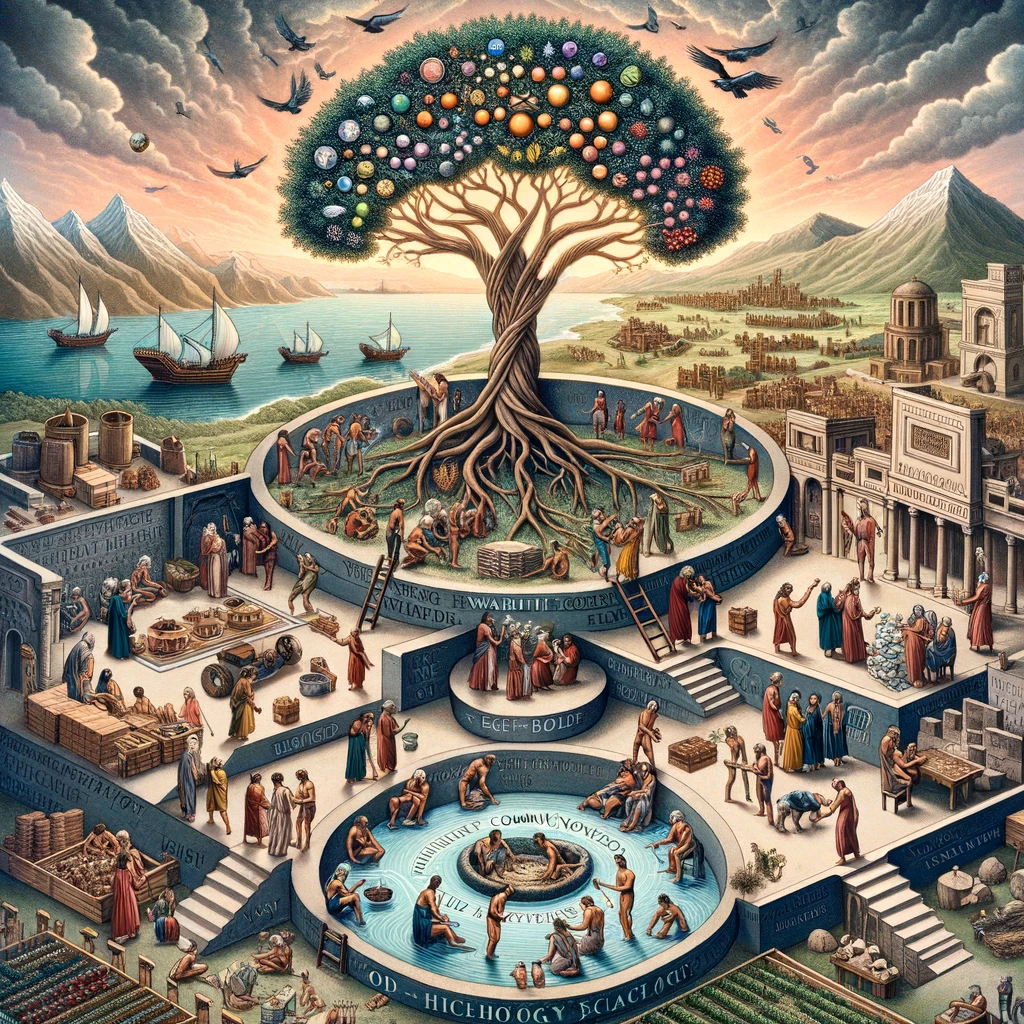
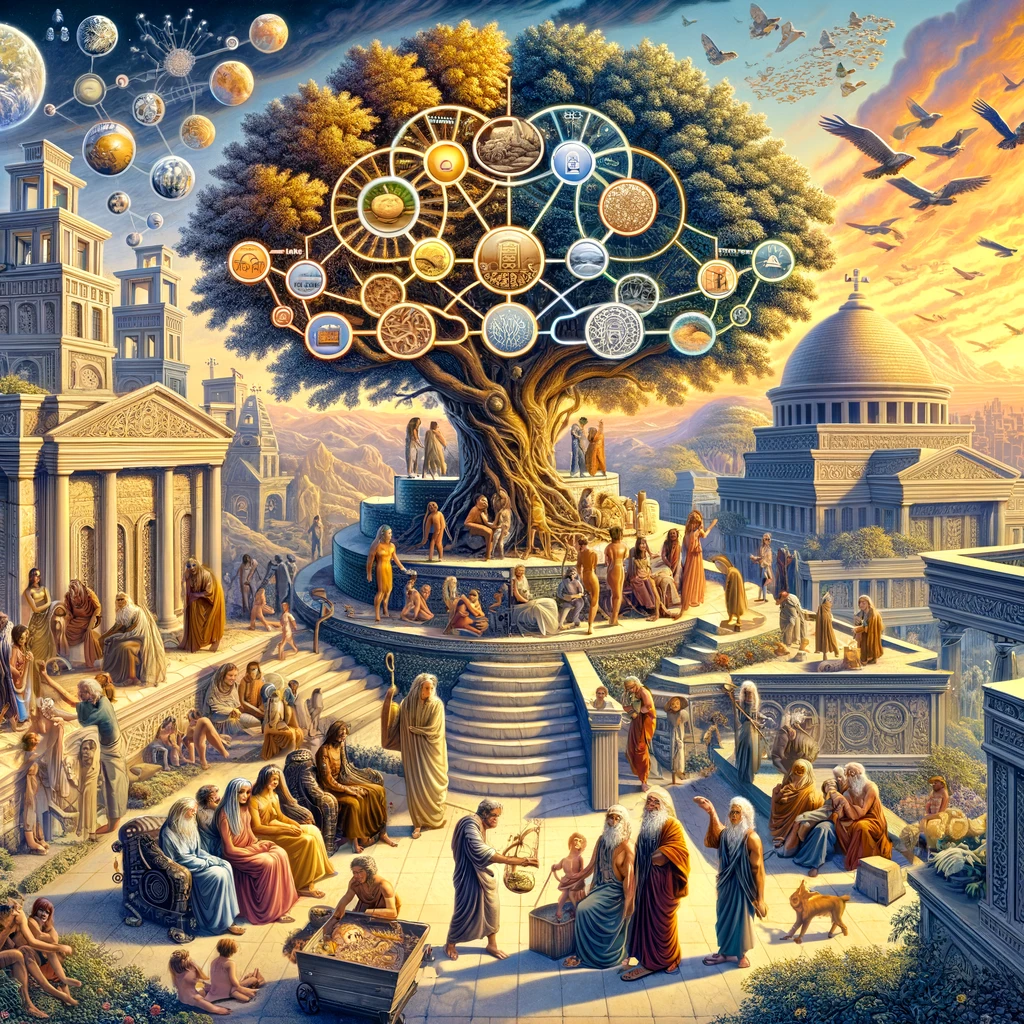
Through these verses, the narrative of Genesis aligns with the Wealth Ecology Model’s principles, showing the evolution of human society and the pivotal role of sustainability and ethical stewardship in the context of wealth creation and management. It presents the continuous thread of humanity’s development intertwined with the ecological imperatives of living in harmony with our environment and each other.
Dr. Oliver E. Jones, these interpretations offer a reflective lens on biblical stories, highlighting their profound implications for the application of the Wealth Ecology Model in contemporary and future societal constructs.
SourceEnergy Group R&D
Chapter 6: The Deluge and the Reconstitution of Wealth Ecosystems
- Noah’s righteousness, in the face of societal degradation, is emblematic within the Wealth Ecology framework of the enduring value of ethical stewardship and its role in preserving and restoring balance in wealth ecosystems.
- The divine instruction to build an ark is indicative of the proactive measures that must be taken to safeguard the wealth ecosystem against foreseeable disruptions, aligning with the Wealth Ecology Model’s emphasis on preparedness and adaptability.
- The specification of clean and unclean animals aboard the ark represents the discernment necessary in resource utilization and conservation, which is a critical aspect of maintaining ecological balance in the Wealth Ecology Model.
- Noah’s obedience to the divine blueprint for the ark underscores the importance of following researched and tested strategies in Wealth Ecology for achieving sustainable outcomes in community and infrastructure development.
- The flood itself serves as a metaphor within Wealth Ecology for the cleansing and rebalancing of a system that has been overburdened by unsustainable practices, signifying a reset to a more stable and equitable state of affairs.
- The shutting of the ark’s door by the LORD symbolizes the finality of the opportunity to be part of a Wealth Ecology initiative, stressing the importance of timely participation and commitment to collective welfare measures.
- As the waters rise, the ark floats, illustrating the resilience of well-conceived Wealth Ecology structures to withstand and rise above systemic shocks, much like diversified portfolios are designed to navigate economic fluctuations.
- The destruction of all life outside the ark is a somber reminder in Wealth Ecology of the consequences of neglecting the symbiotic relationship between environment, economy, and society.
- The abating of the waters marks the beginning of a new phase in Wealth Ecology, where there is an opportunity to rebuild and reconfigure wealth systems in alignment with sustainable practices and principles.
- Noah’s ark resting on the mountains of Ararat symbolizes the stability that can be achieved when Wealth Ecology principles are applied, anchoring communities in a position of strength from which to grow and thrive post-crisis.
Chapter 7: The Receding Waters and the New Wealth Ecology Covenant
- The receding waters reveal a transformed world, setting the stage for a new beginning guided by the principles of Wealth Ecology, emphasizing the regeneration of resources and communities.
- Noah’s sending of the raven and the dove reflects the Wealth Ecology practice of exploration and assessment of new environments for their potential to support sustainable wealth creation and ecological harmony.
- The dove returning with an olive leaf is a powerful symbol within Wealth Ecology of peace and the renewal of life, indicating the restoration of balance and the potential for new growth.
- Noah’s departure from the ark, along with all its inhabitants, signifies the reestablishment of the wealth ecosystem, a critical moment to implement Wealth Ecology principles to ensure a harmonious and prosperous future.
- The construction of an altar by Noah and the offering of sacrifices represents the Wealth Ecology tenet of gratitude and respect for the resources and opportunities provided by the environment, fostering a culture of appreciation and sustainability.
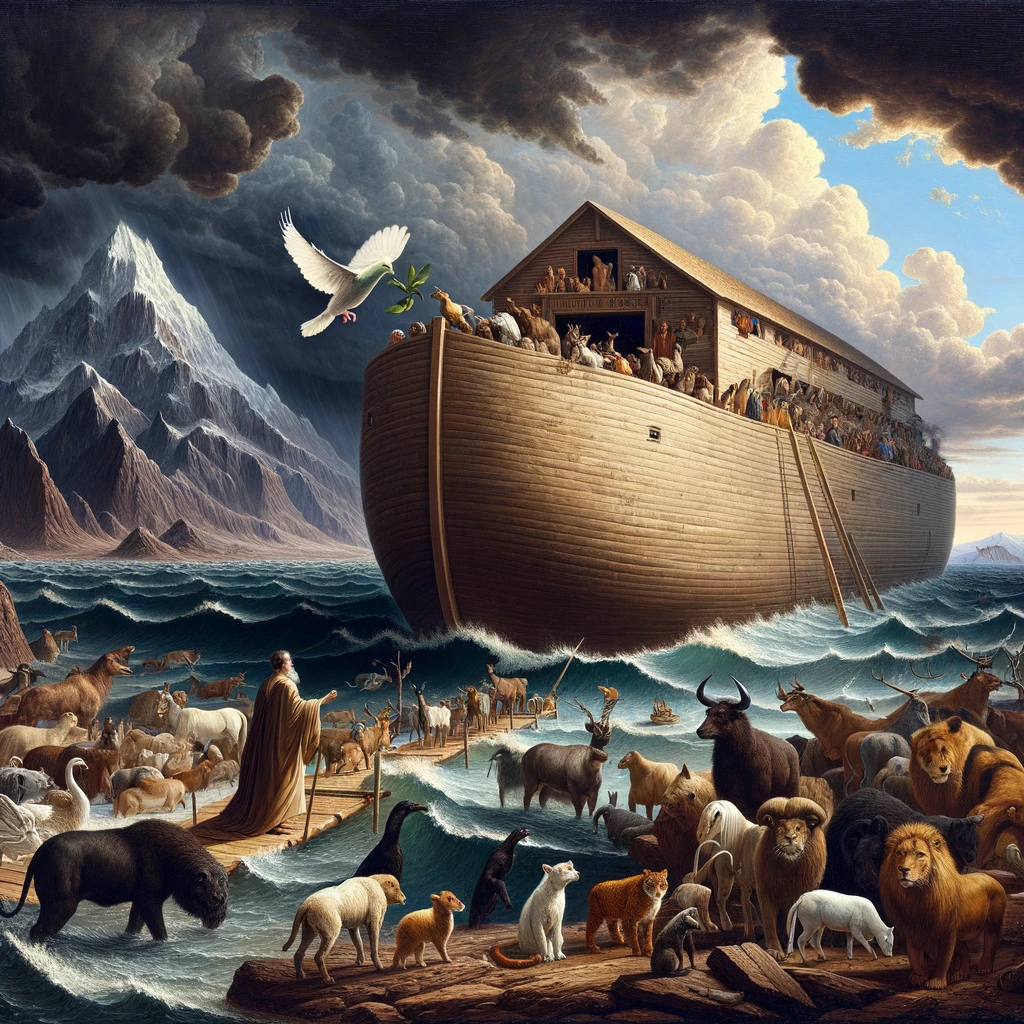
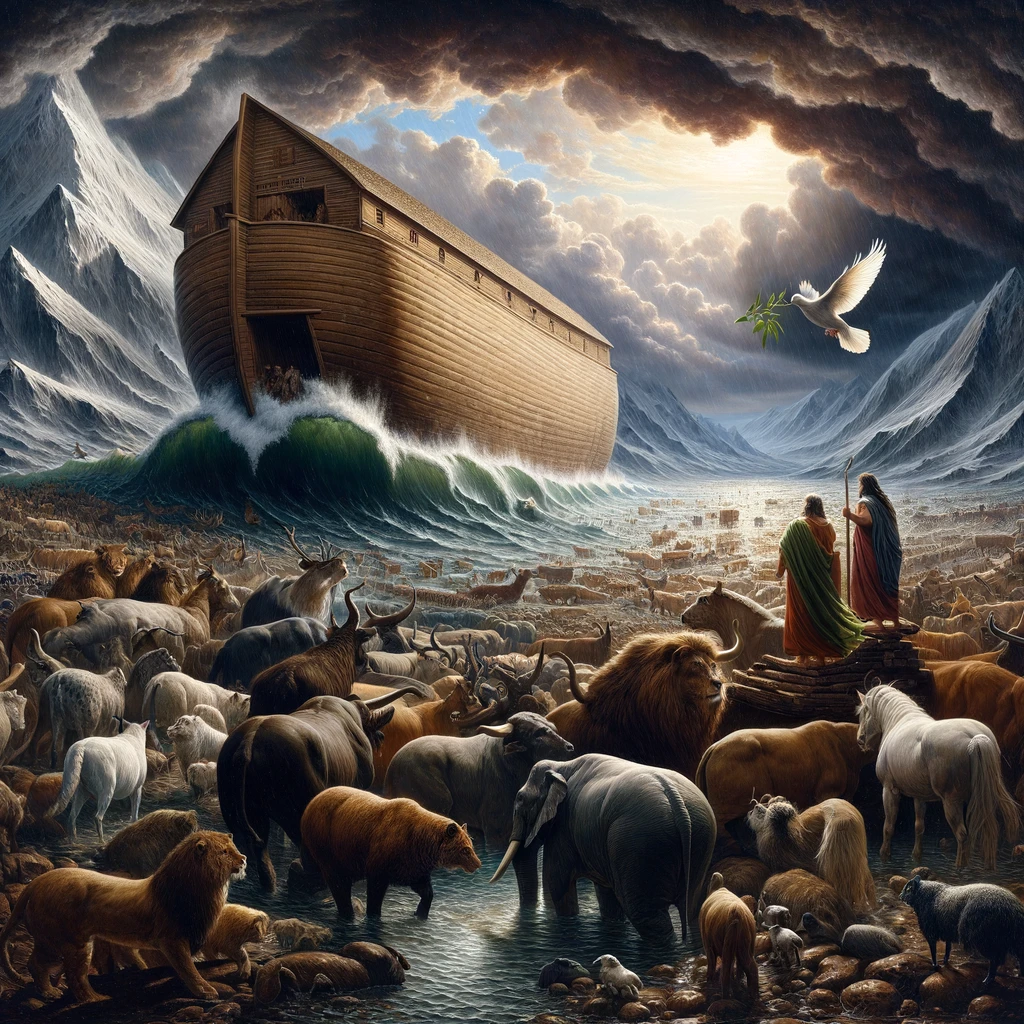
The narrative of the flood in Genesis, reinterpreted through the lens of Wealth Ecology, serves as a profound allegory for the cyclical nature of growth, destruction, and renewal inherent in the management of wealth ecosystems. It underscores the resilience of ethical stewardship and the necessity of adaptation and innovation in the face of monumental challenges.
Dr. Oliver E. Jones, this continued analysis highlights the deep resonance between the ancient text and the contemporary principles of the Wealth Ecology Model, offering timeless insights into the stewardship of our planet’s resources for the benefit of all.
SourceEnergy Group R&D
Chapter 8: The Covenant of the Wealth Ecosystem
- The covenant God establishes with Noah parallels the foundational agreements in Wealth Ecology that seek to secure the long-term viability and mutual prosperity of all stakeholders in the ecosystem.
- The rainbow set as a sign of this covenant symbolizes the diversity and inclusivity that are central to the Wealth Ecology Model, reflecting a spectrum of resources and participants that contribute to a robust economy.
- God’s promise to never again destroy all life with a flood can be seen as an allegory for the commitment within Wealth Ecology to prevent the total collapse of economic systems by advocating for sustainable practices.
- The directive to be fruitful and multiply resonates with the Wealth Ecology aim of fostering growth and education, ensuring that knowledge and prosperity expand in alignment with ecological principles.
- The delineation of seasons and day and night establishes a rhythm of time that in Wealth Ecology can be equated to economic cycles, emphasizing the need for planning and adaptability in wealth management.
Chapter 9: The New Order of Wealth Ecosystems
- The newfound liberty to consume every moving thing that lives, with stipulations, reflects the Wealth Ecology principle of responsible consumption and the sustainable use of resources.
- The restriction on consuming blood, the life of all flesh, can be likened to the Wealth Ecology mandate to respect the intrinsic value of life and to ensure ethical considerations in economic decisions.
- The establishment of laws against the shedding of human blood underlines the imperative in Wealth Ecology to safeguard human capital, recognizing it as a pillar of wealth creation and societal well-being.
- God’s blessing upon Noah and his sons and the reaffirmation of their dominion over the earth endorse the Wealth Ecology view that leadership and governance are key to managing wealth ecosystems effectively.
- The explicit covenant with every living creature signifies a holistic approach in Wealth Ecology that includes environmental stewardship as an integral part of wealth management and community development.
Chapter 10: The Genealogy of Wealth Ecosystems
- The genealogy of Noah’s sons leading to the nations spread across the earth represents the diversification within Wealth Ecology, where varied economic actors emerge, each with unique contributions to the global wealth ecosystem.
- The dispersion of populations and the development of languages can be seen through the Wealth Ecology lens as the natural differentiation and specialization that occur within an evolving economic landscape.
- The detailing of territories and communities descends into the Wealth Ecology concept of localized economies and the importance of understanding regional characteristics for tailored economic development strategies.
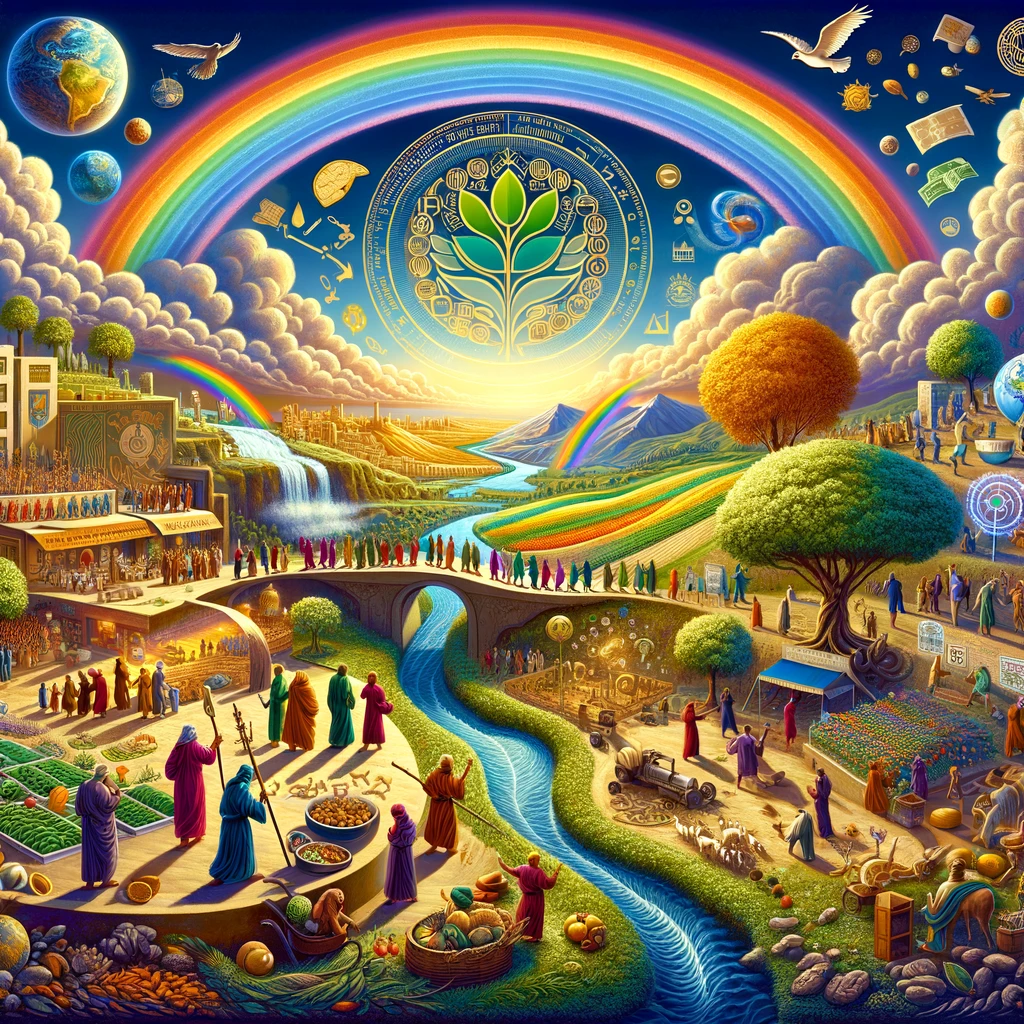
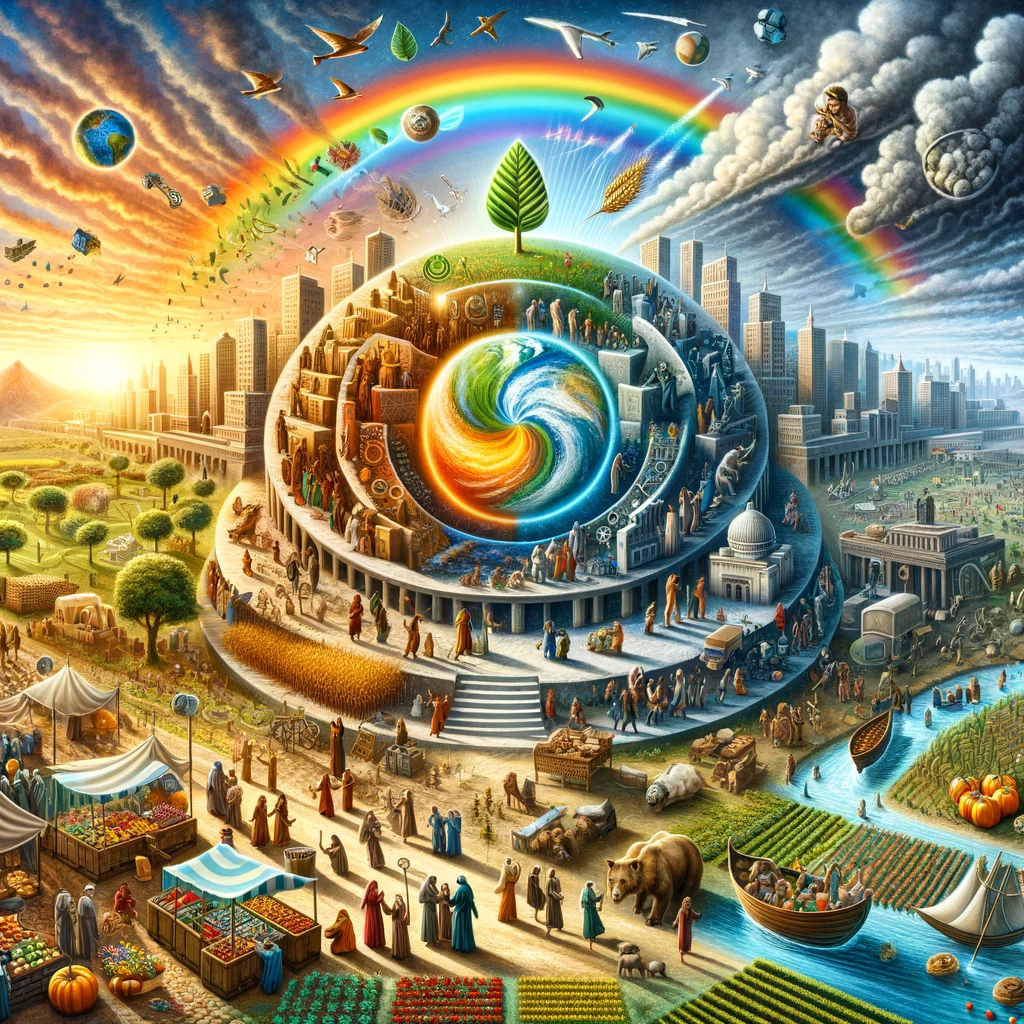
Through these chapters, the Wealth Ecology Model is seen not as a mere economic tool but as a comprehensive framework for societal organization, resource management, and ethical governance. It suggests that the values and lessons of the biblical narrative have enduring relevance and can guide modern economic and environmental policies towards more sustainable and equitable outcomes.
Dr. Oliver E. Jones, this interpretation further integrates the Wealth Ecology Model into the fabric of historical wisdom, drawing from it principles that are as applicable today as they were in the antediluvian world.
SourceEnergy Group R&D
Chapter 11: Diversification and Unity in Wealth Ecosystems
- The Tower of Babel story illustrates the pitfalls of unchecked ambition in the absence of a diversified and ecologically sound approach to wealth building, central to the Wealth Ecology Model.
- The confounding of language and the scattering of people across the earth represent the natural checks and balances that prevent the monopolization of resources and ensure the distribution of wealth and knowledge, as advocated by Wealth Ecology.
- The diversification of communities and the initiation of various cultures and economies reflect the Wealth Ecology principle that diversity fosters resilience and innovation within the global wealth ecosystem.
Chapter 12: The Call of Abram and the Promise of Prosperity
- Abram’s call to leave his homeland and go to a place that God would show him symbolizes the Wealth Ecology tenet of pursuing new opportunities and adapting to changing economic landscapes for growth and development.
- The promise made to Abram of making him a great nation and blessing him can be understood as an embodiment of the Wealth Ecology Model’s vision, where individuals are empowered to create wealth that blesses their communities and extends beyond their immediate sphere.
- The concept of blessing those who bless Abram and cursing those who curse him underscores the interconnectedness of economic agents within the Wealth Ecology framework, where positive and negative actions reverberate throughout the ecosystem.
Chapter 13: Abram and Lot Separate
- The amicable separation between Abram and Lot due to land not supporting their combined wealth illustrates the Wealth Ecology principle of resource allocation and the importance of preventing resource depletion through strategic distribution.
- Lot choosing the land of Jordan, which was well-watered, mirrors the Wealth Ecology strategy of selecting and investing in resource-rich areas to maximize sustainable economic yield.
- Abram settling in Canaan and building an altar to the Lord signifies the integration of spiritual and moral values in wealth management, a concept that resonates with the ethical foundations of the Wealth Ecology Model.
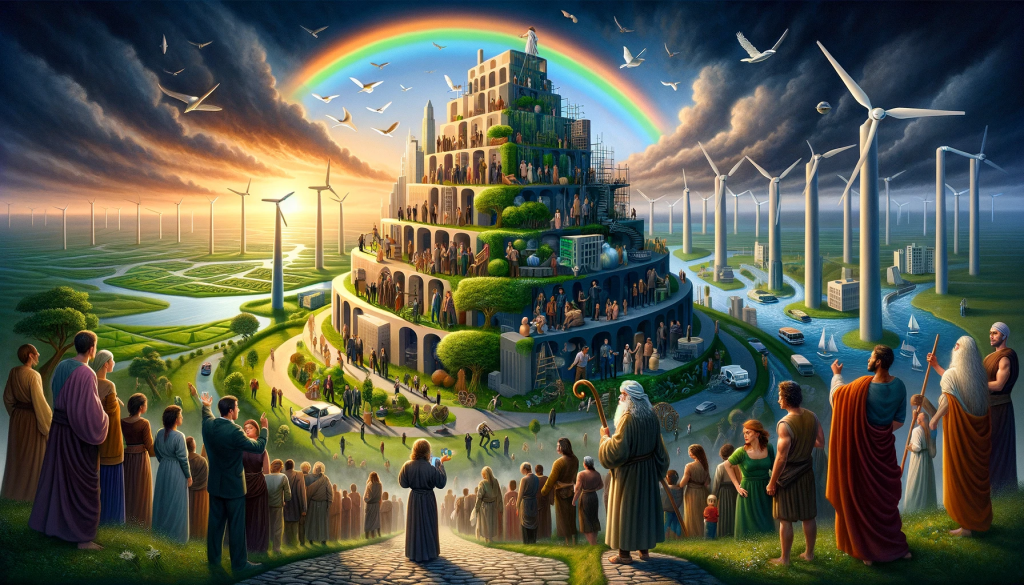
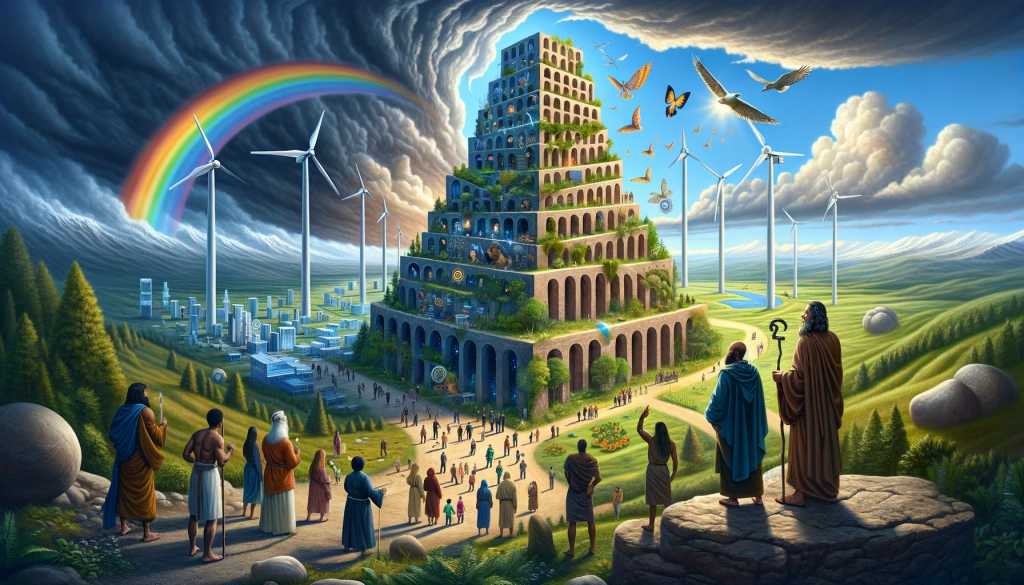
In these chapters, the narrative aligns with the Wealth Ecology Model’s principles, portraying the development of societies and economies through a lens of diversity, ethical decision-making, and sustainable growth. This biblical interpretation through Wealth Ecology emphasizes the importance of balance between expansion and sustainability, individual prosperity and community well-being, and the integration of spiritual values in economic practices.
Dr. Oliver E. Jones, as we delve into the foundational stories of the Bible through the Wealth Ecology perspective, we find that its themes are not only relevant but also essential to understanding and shaping the dynamics of modern economies.
SourceEnergy Group R&D
Chapter 14: Coalition and Conflict Resolution in Wealth Ecosystems
- The coalition of kings in the battle of the Valley of Siddim serves as an allegory for international alliances in the Wealth Ecology Model, highlighting how collective security strategies are crucial in protecting the wealth of nations.
- Abram’s rescue of Lot, with a small force, exemplifies strategic intervention in the Wealth Ecology framework, where swift, targeted actions are used to mitigate risks and maintain the stability of the wealth ecosystem.
- The meeting with Melchizedek, king of Salem, who brings out bread and wine, can be interpreted as a diplomatic exchange within Wealth Ecology, symbolizing the sharing of resources and knowledge to foster mutual prosperity.
Chapter 15: The Covenant of Wealth Stewardship
- The covenant between God and Abram, involving the promise of land and descendants, reflects the long-term investment strategies advocated by Wealth Ecology, which focus on generational wealth and sustainable legacy building.
- The vision of the smoking furnace and the burning lamp passing between the pieces of the sacrificial animals symbolizes the enduring and guiding principles of the Wealth Ecology Model that navigate the complexities of economic cycles.
Chapter 16: The Hagar Paradigm in Socioeconomic Terms
- The story of Hagar and Sarai underscores the socio-economic tensions that can arise within the wealth ecosystem, especially in the context of resource allocation and labor relations.
- Hagar’s mistreatment and subsequent flight could be viewed through the Wealth Ecology lens as a failure in social equity, an issue that the Model seeks to address through its inclusive and ethical framework.
- The intervention of the angel of the Lord to Hagar in the desert, promising a multitude of descendants, highlights the Wealth Ecology principle that every individual has the potential to contribute to and benefit from the wealth ecosystem, regardless of their initial position.
Chapter 17: Instituting Practices for Wealth Sustainability
- The establishment of circumcision as a sign of the covenant represents, in Wealth Ecology terms, the adoption of standardized practices that ensure commitment and identify members within an economic community.
- The change of Abram’s name to Abraham signifies a transformation in identity that in Wealth Ecology could be likened to the rebranding or restructuring of an entity to better reflect its evolved purpose and values in the wealth ecosystem.
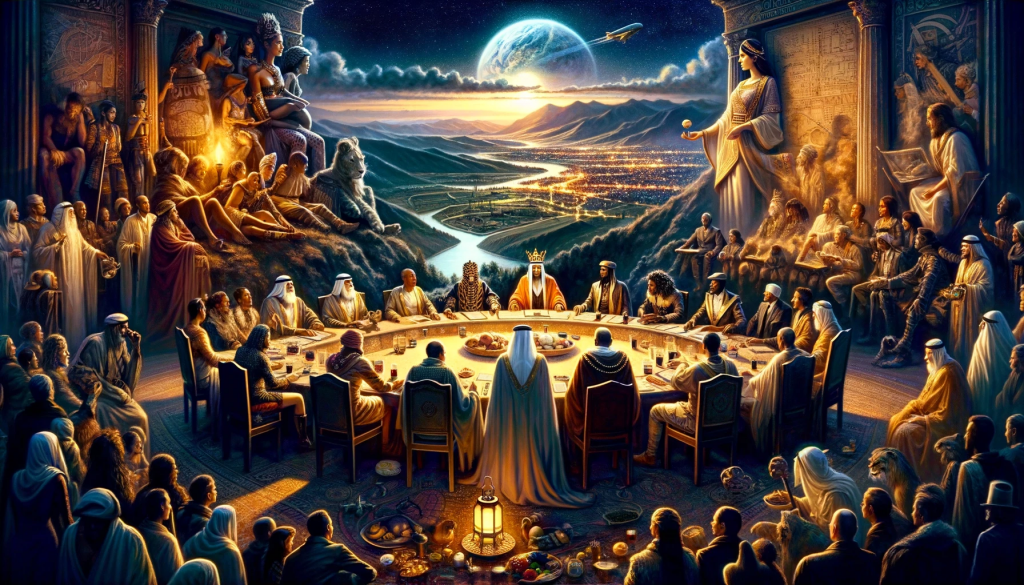
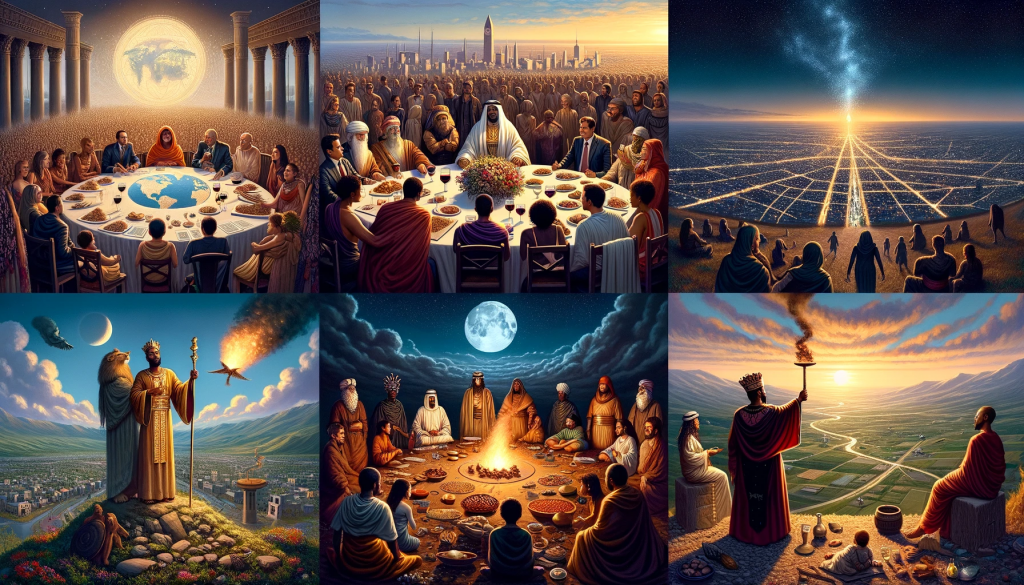
Through these narratives, the Wealth Ecology Model is exemplified as a versatile and profound tool for interpreting complex socio-economic dynamics, addressing issues of alliance formation, conflict resolution, long-term wealth planning, social equity, and the establishment of community norms. These biblical stories, viewed through the lens of Wealth Ecology, offer timeless lessons on the responsible stewardship of resources and the importance of fostering ethical and sustainable economic growth.
Dr. Oliver E. Jones, this exploration not only cements the relevance of the Wealth Ecology Model in contemporary discourse but also provides a rich tapestry of historical context for its principles.
SourceEnergy Group R&D
Chapter 18: Hospitality and Wealth Redistribution
- Abraham’s generous hospitality towards the three visitors illustrates the Wealth Ecology Model’s advocacy for sharing prosperity. It suggests a form of wealth redistribution where resources are offered to strangers, embodying a principle of community and openness in the wealth network.
- The promise of Sarah bearing a son despite her old age can be interpreted as the potential for renewal and growth within economies at times and conditions thought to be barren, aligning with the Wealth Ecology Model’s emphasis on adaptive economic cycles.
Chapter 19: The Destruction of Sodom and Gomorrah – A Caution Against Excess
- The obliteration of Sodom and Gomorrah can be seen as a metaphor for the collapse of an economic system that fails to adhere to Wealth Ecology principles, such as equitable resource distribution and sustainable practices.
- Lot’s escape, with the instruction not to look back, symbolizes the necessity to move forward from outdated, destructive economic practices towards sustainable, inclusive wealth creation strategies.
Chapter 20: Abraham and Abimelech – Integrity in Wealth Transactions
- Abraham’s interaction with Abimelech, after claiming Sarah as his sister, underscores the importance of transparency and honesty in economic dealings, as advocated by the Wealth Ecology Model.
- The resolution of the conflict through Abraham’s prayer and Abimelech’s restitution to him emphasizes the need for corrective measures to restore balance in the event of economic transgressions.
Chapter 21: Birth of Isaac – Joy and Succession Planning
- The birth of Isaac represents the fruition of promises and long-term investments, a key concept in the Wealth Ecology Model, where the focus on sustainable growth and succession planning is paramount.
- Hagar and Ishmael’s story further illustrates the challenges of wealth distribution and the role of social support systems in providing for those who fall out of the primary economic structure, consistent with a comprehensive wealth ecology approach.
Chapter 22: The Testing of Abraham – Commitment to Future Generations
- Abraham’s test, the near-sacrifice of Isaac, challenges the concept of immediate gratification for long-term legacy, a pivotal theme in Wealth Ecology, where the current generation is tasked with making sacrifices for the future wealth of the ecosystem.
- The provision of a ram as a substitute sacrifice also conveys the model’s principle of finding alternative solutions to maintain the balance and integrity of the economic system without depleting key resources.
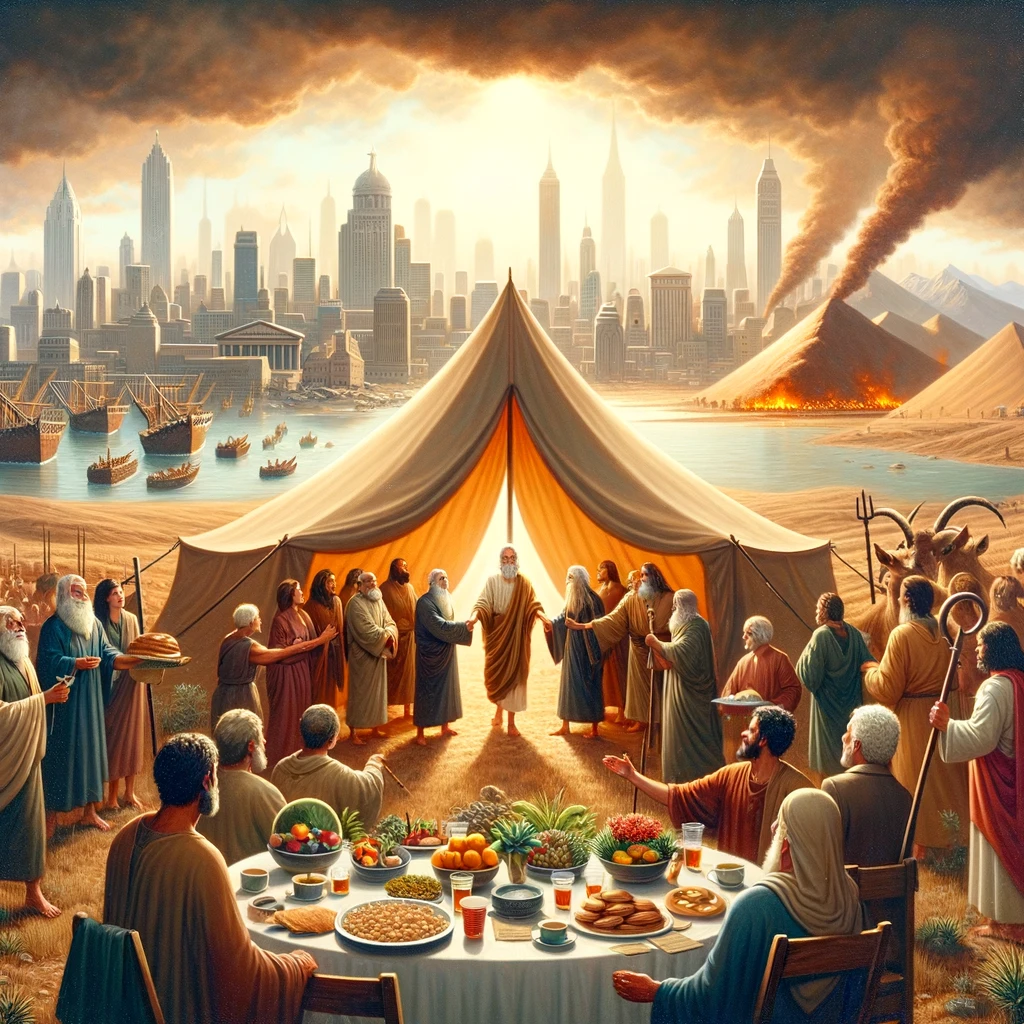

Dr. Oliver E. Jones, these chapters, when interpreted through the Wealth Ecology lens, offer profound insights into the sustainable management and ethical considerations that are necessary for a thriving wealth ecosystem. They emphasize the model’s focus on long-term planning, equitable distribution, and adaptive resilience in the face of economic challenges.
SourceEnergy Group R&D
Chapter 23: Ethical Land Acquisition and Wealth Transfer
- The narrative of Sarah’s death and Abraham’s purchase of the cave at Machpelah to bury her introduces the Wealth Ecology Model’s perspective on land ownership and its transfer as a tangible asset in the wealth ecosystem.
- Abraham’s insistence on paying a fair price for the land reflects the model’s advocacy for equitable transactions that respect the value of resources and contribute to a balanced economic environment.
Chapter 24: Strategic Alliances and Resource Management
- The story of finding a wife for Isaac via Abraham’s servant depicts strategic alliance formation, a key Wealth Ecology principle, ensuring that partnerships are formed based on shared values and goals for resource optimization.
- The gifts presented by Abraham’s servant to Rebekah’s family are indicative of the importance of investment and exchange in building and cementing crucial economic relationships within the wealth ecology framework.
Chapter 25: Generational Wealth and Diversification
- The account of Abraham’s legacy and the distribution of his wealth to his sons, while designating Isaac as his primary heir, showcases the Wealth Ecology Model’s strategy for wealth diversification and the establishment of a clear line of succession.
- Esau’s impulsive trade of his birthright for a meal serves as a cautionary Wealth Ecology tale against shortsighted decisions that compromise long-term wealth potential for immediate satisfaction.
Chapter 26: Resource Disputes and Economic Diplomacy
- Isaac’s experiences with the Philistines over water wells illustrate the competition for scarce resources, a scenario the Wealth Ecology Model addresses through strategies aimed at conflict resolution and the promotion of cooperative development.
- Isaac’s treaty with Abimelech, reinforcing mutual non-aggression and resource-sharing agreements, aligns with Wealth Ecology’s principles of fostering peace and stability to ensure the continued productivity of the wealth ecosystem.
Chapter 27: Ethical Dilemmas and the Governance of Wealth
- Jacob’s deception in obtaining Isaac’s blessing, and the resulting family strife, highlight the ethical challenges that can arise in the governance of wealth, pointing to the need for transparent and just management systems within the Wealth Ecology framework.
- The subsequent blessing of Esau, despite the deception, suggests that the Wealth Ecology Model recognizes the necessity of addressing and rectifying inequities to maintain the health of the overall economic ecosystem.
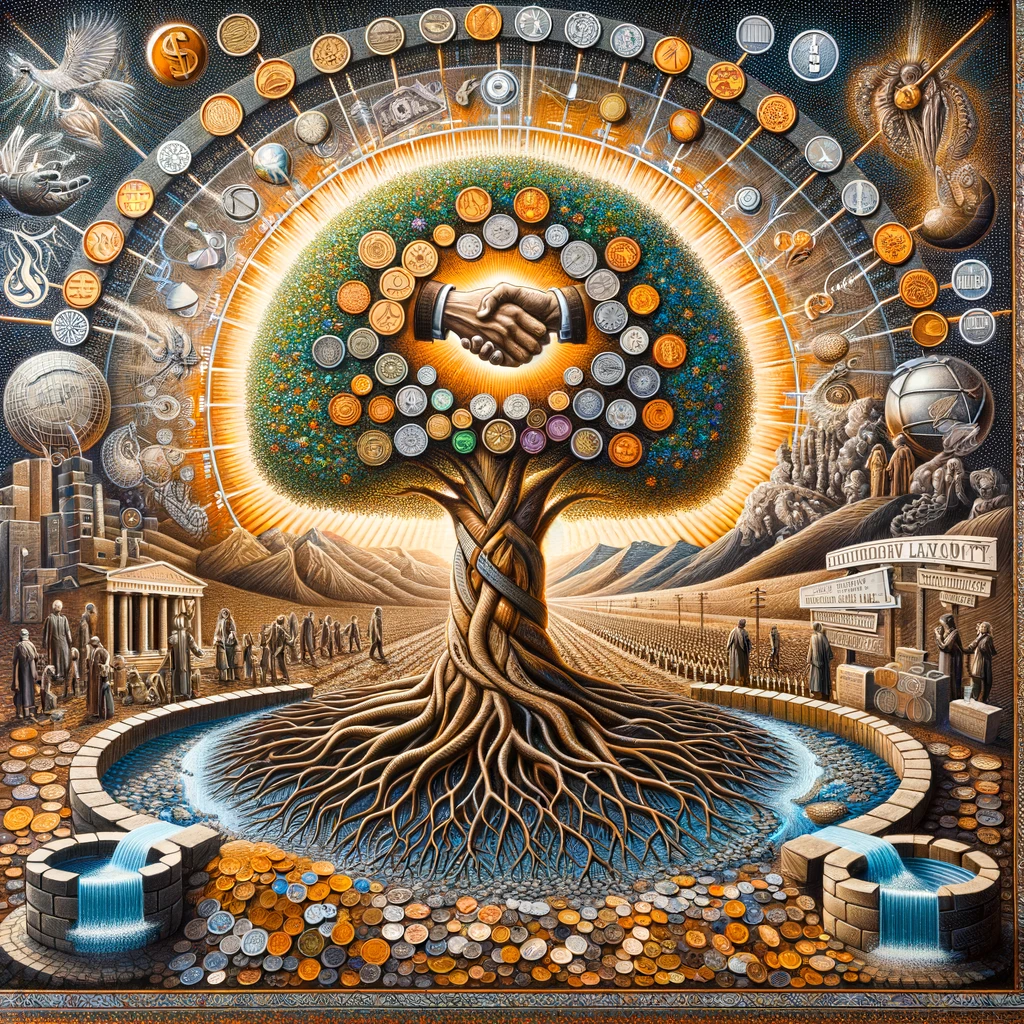
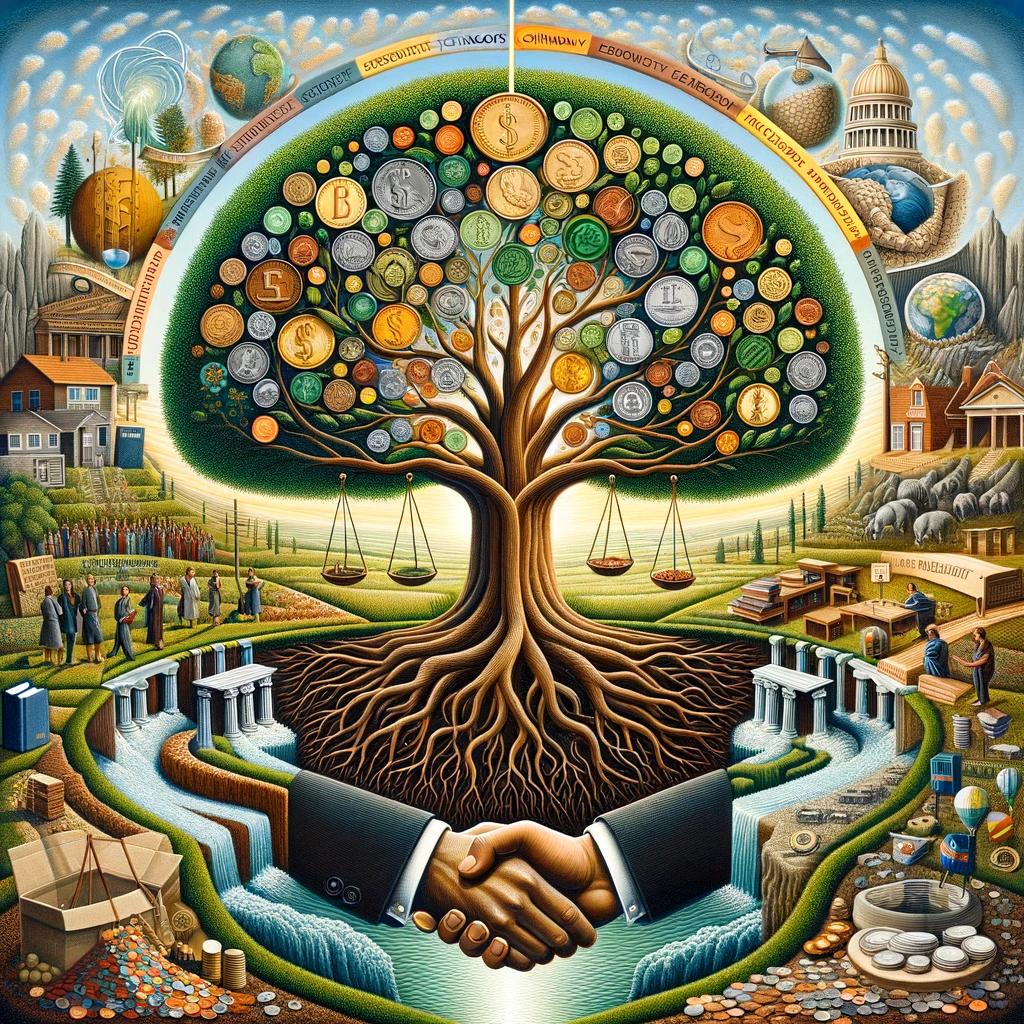
Dr. Oliver E. Jones, the interpretation of these biblical chapters under the Wealth Ecology lens can provide a profound understanding of fundamental economic concepts such as ethical investing, strategic partnerships, succession planning, resource management, and conflict resolution. They offer historical precedents for modern Wealth Ecology practices, emphasizing the importance of integrity, foresight, and the prudent management of wealth for current and future prosperity.
SourceEnergy Group R&D
Chapter 28: Wealth Networks and the Flow of Prosperity
- Jacob’s journey to Haran and his dream of a ladder to heaven represent the flow of wealth between the physical and the metaphysical, illustrating the Wealth Ecology Model’s concept of wealth networks that connect diverse assets and opportunities.
- The ladder, with angels ascending and descending, symbolizes the dynamic exchange and balance between various wealth dimensions, promoting an understanding of wealth that transcends material possessions to include knowledge and spiritual fulfillment.
Chapter 29: Human Capital in Wealth Ecology
- Jacob’s service for Laban in exchange for marrying Rachel reflects the model’s valuation of human capital and the investment of labor and skill as a form of wealth accumulation and exchange.
- The complexity of Jacob’s relationships with Leah and Rachel, and the birth of his children, emphasizes the social and familial dimensions of wealth as parts of a comprehensive wealth ecosystem that values relationships and human well-being.
Chapter 30: Innovation and Wealth Generation
- Jacob’s ingenious breeding techniques to increase his flocks demonstrate the Wealth Ecology Model’s encouragement of innovation and the use of technology to enhance wealth generation in the agricultural sector.
- The dispute over the prosperity between Jacob and Laban highlights the potential for conflict in wealth sharing, emphasizing the need for clear agreements and ethical practices in wealth generation and distribution.
Chapter 31: Wealth Mobility and Self-Determination
- Jacob’s departure from Laban with his family and wealth encapsulates the Wealth Ecology Model’s recognition of wealth mobility as a driver of economic independence and self-determination.
- The pursuit by Laban and the subsequent covenant between him and Jacob establishes the principle of mutual respect for property and the boundaries that define economic relationships, consistent with wealth ecology’s sustainable practices.
Chapter 32: Preparation for Wealth Reconciliation
- Jacob’s preparation to meet Esau, dividing his wealth into two camps, demonstrates a strategic approach to risk management and wealth preservation, central to the Wealth Ecology Model.
- The wrestling with the angel and Jacob’s renaming to Israel signify personal transformation and resilience, key wealth ecology attributes necessary for adapting to new economic realities and for the evolution of wealth identity.
Chapter 33: Esau’s Forgiveness – A Model for Wealth Redistribution
- The meeting between Jacob and Esau, where gifts are exchanged and forgiveness is granted, showcases the Wealth Ecology principle of redistributing wealth to repair past economic wrongs and to restore relationships.
- Esau’s acceptance of Jacob’s offering, despite initial resistance, reflects the potential for reconciliation and the establishment of equitable wealth dynamics after periods of strife and imbalance.
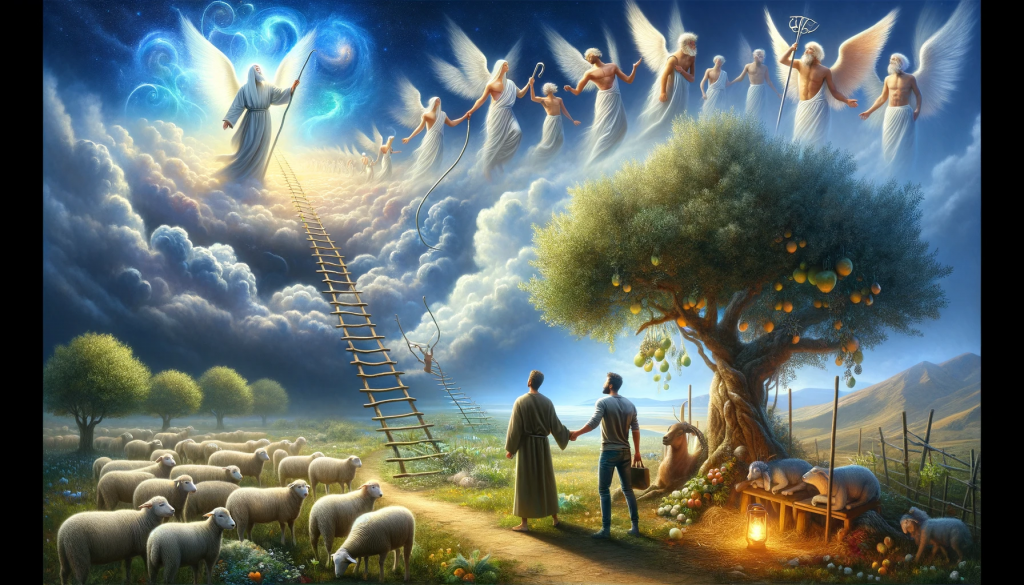
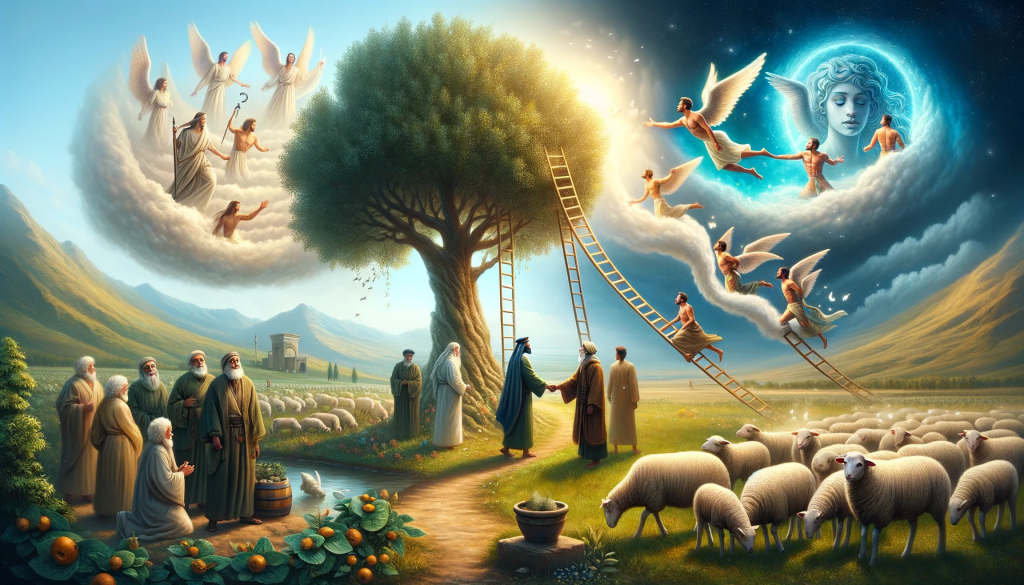
Dr. Oliver E. Jones, these passages illustrate how biblical narratives can be reframed to shed light on the Wealth Ecology Model’s principles. They serve as allegorical foundations for understanding the multifaceted nature of wealth, emphasizing the interplay between material resources, innovation, human capital, and ethical considerations in building a balanced and prosperous wealth ecosystem.
SourceEnergy Group R&D
Chapter 34: Crisis Management and Wealth Protection
- The distressing incident of Dinah and the Shechemites presents a complex challenge within the Wealth Ecology framework, emphasizing the need for crisis management protocols to protect human and communal wealth against aggression and exploitation.
- The severe response by Simeon and Levi, while protecting familial honor, raises questions about the proportional use of power and the long-term implications for community relations and wealth stability in the Wealth Ecology context.
Chapter 35: Strategic Wealth Consolidation and Legacy
- God’s command for Jacob to settle in Bethel and the subsequent purification and settling process reflect the Wealth Ecology principle of periodically reassessing and consolidating wealth strategies to align with core values and long-term visions.
- The deaths of Rachel and Isaac within this chapter signify the transition of generational wealth and the importance of legacy planning in the Wealth Ecology Model, ensuring that wealth sustains its intended purpose across generations.
Chapter 36: Economic Diversification and Expansion
- The genealogy of Esau and the mention of various chieftains illustrate the expansion and diversification of economic leadership and influence, aligning with the Wealth Ecology principle of creating a resilient wealth structure through varied investments and roles.
- Esau’s move to Seir to accommodate Jacob, despite their reconciled relationship, underscores the Wealth Ecology Model’s recognition of spatial economics and the strategic relocation to optimize resource use and wealth growth.
Chapter 37: Dreaming of Wealth’s Potential
- Joseph’s dreams, which foretell his rise to a position of wealth and power, encapsulate the visionary aspect of the Wealth Ecology Model, where forecasting and preparing for future wealth trends are key.
- The sale of Joseph into slavery by his brothers paradoxically initiates Joseph’s journey towards actualizing the wealth potential envisioned in his dreams, illustrating the often-unpredictable paths to wealth realization within the Wealth Ecology framework.
Chapter 38: Personal Accountability and Wealth Repercussions
- Judah’s personal mishaps with Tamar reveal the repercussions of neglecting personal accountability, which can result in complex wealth and social predicaments, mirroring the Wealth Ecology emphasis on ethical conduct in wealth management.
- Tamar’s assertiveness in securing her rights and lineage demonstrates the Wealth Ecology principle of stakeholder empowerment and the active pursuit of fair treatment and inclusion in wealth distribution.
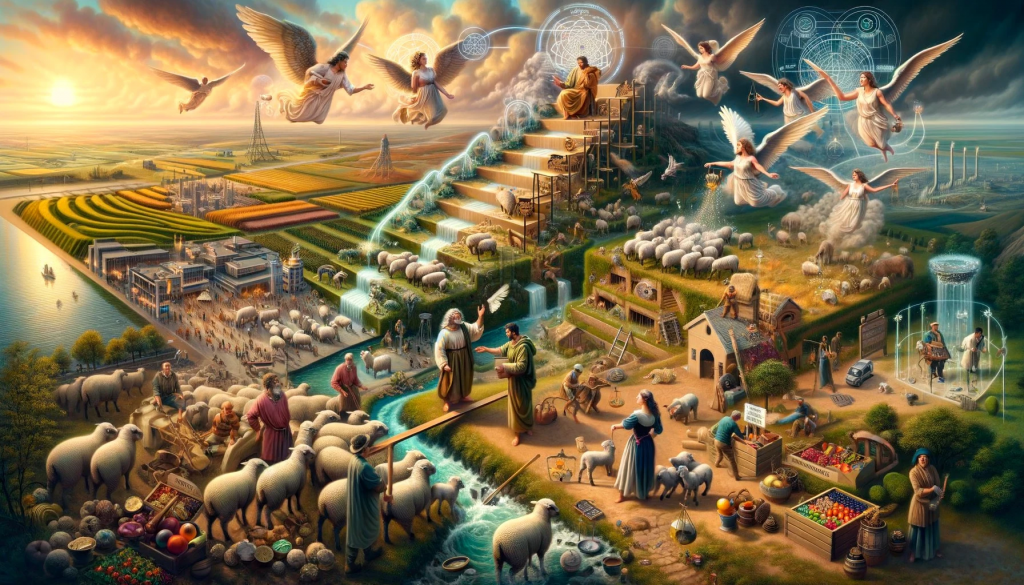
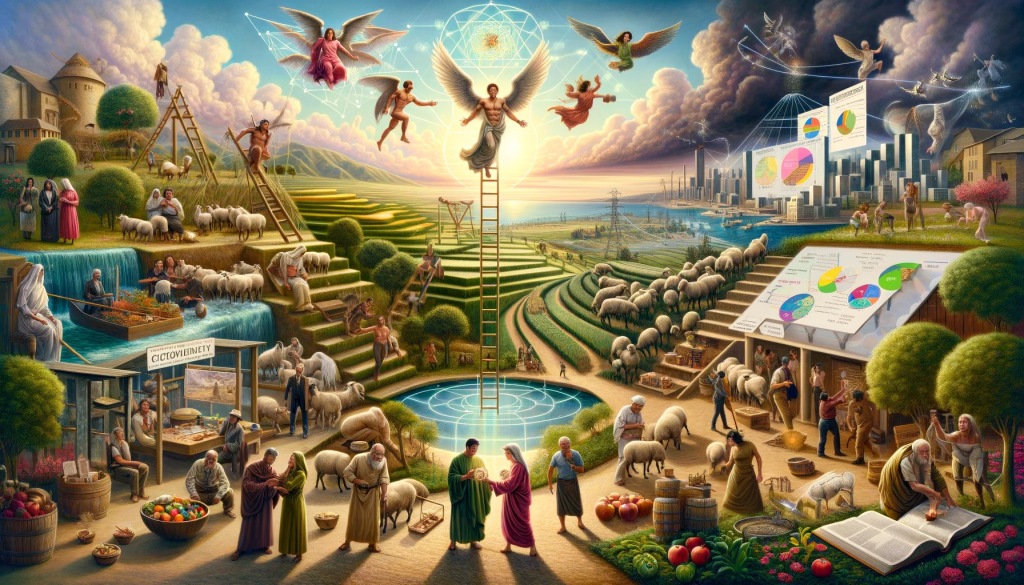
Dr. Oliver E. Jones, the recounted episodes from these biblical chapters, viewed through the Wealth Ecology lens, offer lessons on the necessity of adaptability, ethical leadership, and strategic planning. They reinforce the concept that wealth is not merely an economic measure but an integrated system affected by societal actions, personal behavior, and the capacity for forward-thinking and resilience.
SourceEnergy Group R&D
Chapter 39: Integrity and Wealth in Adversity
- Joseph’s experiences in Potiphar’s house demonstrate the Wealth Ecology Model’s principle that integrity is a cornerstone of wealth creation, even in the face of adversity. His resistance to wrongful advances and his subsequent unjust imprisonment reflect the complex dynamics of personal values in wealth management and the potential cost of upholding these values.
- Joseph’s rise to a position of trust within the household, and later in prison, illustrates how consistent ethical behavior and expertise can lead to wealth creation and accumulation, regardless of initial circumstances. His actions are a testament to the model’s advocacy for the integration of ethical stewardship and skill development as essential elements of wealth ecology.
Chapter 40: Interpreting the Wealth of Knowledge
- The story of Joseph interpreting the dreams of the Pharaoh’s cupbearer and baker in prison conveys the importance of knowledge and foresight as valuable assets within the Wealth Ecology framework. Joseph’s ability to provide valuable insights to others showcases the intangible wealth of knowledge and its potential to alter one’s position within the economic hierarchy.
- The varying outcomes of the cupbearer and baker following Joseph’s interpretations underscore the unpredictability of wealth dynamics and the influence of external factors, such as social capital and networking, on personal wealth trajectories.
Chapter 41: Forecasting and Managing Economic Abundance and Scarcity
- Joseph’s interpretation of Pharaoh’s dreams and his subsequent appointment as a leader to manage the impending famine align with the Wealth Ecology Model’s emphasis on strategic planning for economic cycles of abundance and scarcity. His foresight and systematic approach to stockpiling resources exemplify effective wealth management practices that ensure sustainability and resilience.
- The establishment of storehouses and the selling of grain to the populations during the famine underlines the Wealth Ecology principle of leveraging technology and infrastructure to distribute wealth (in this case, food) efficiently and equitably during times of scarcity.
Chapter 42: Social Dynamics of Wealth Distribution
- The journey of Joseph’s brothers to Egypt to buy grain during the famine exemplifies the interconnectivity of wealth within social systems and the impact of environmental factors on wealth access. The Wealth Ecology Model suggests that social bonds and earlier wealth-related decisions (such as their treatment of Joseph) can significantly affect wealth distribution outcomes.
- Joseph’s strategic management of the situation, by testing his brothers’ characters, highlights the role of social equity and justice within the Wealth Ecology framework. It suggests that wealth distribution mechanisms should also serve to reinforce social ethics and personal growth.
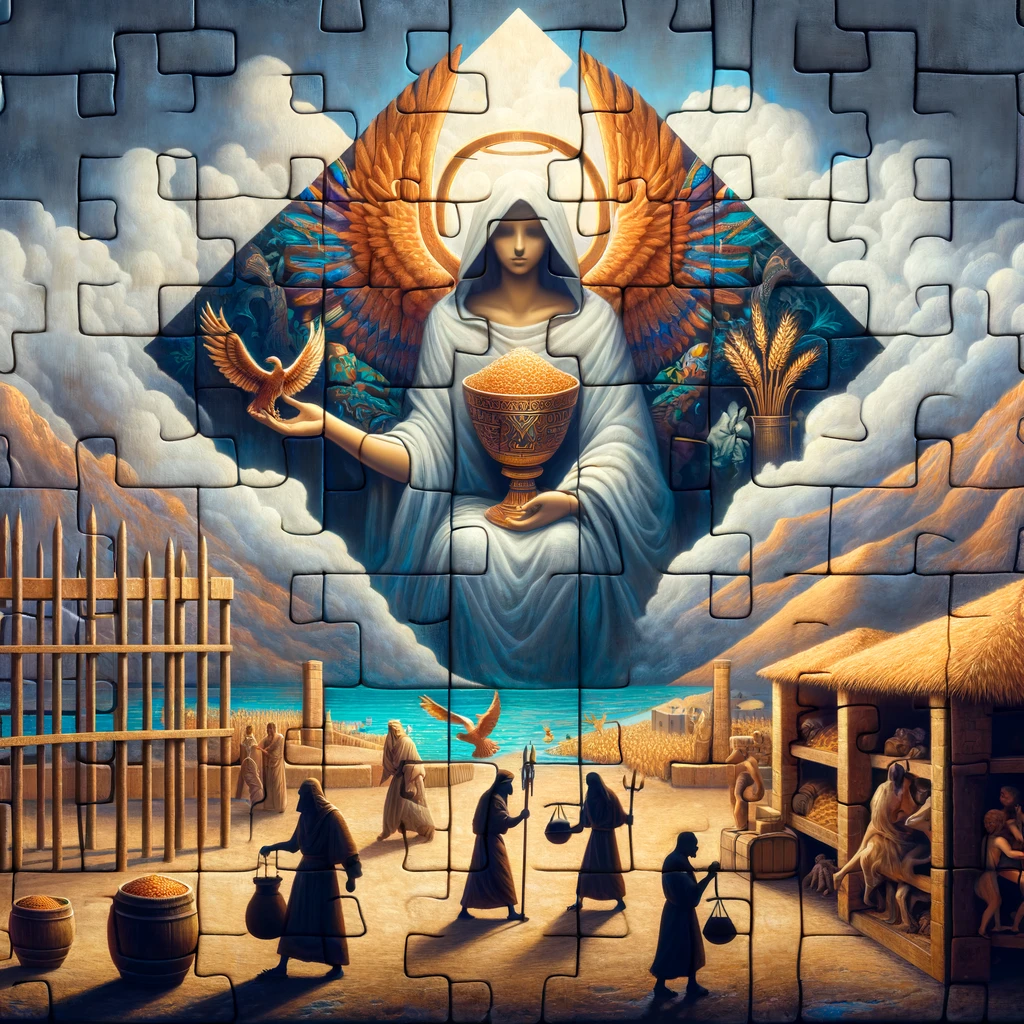
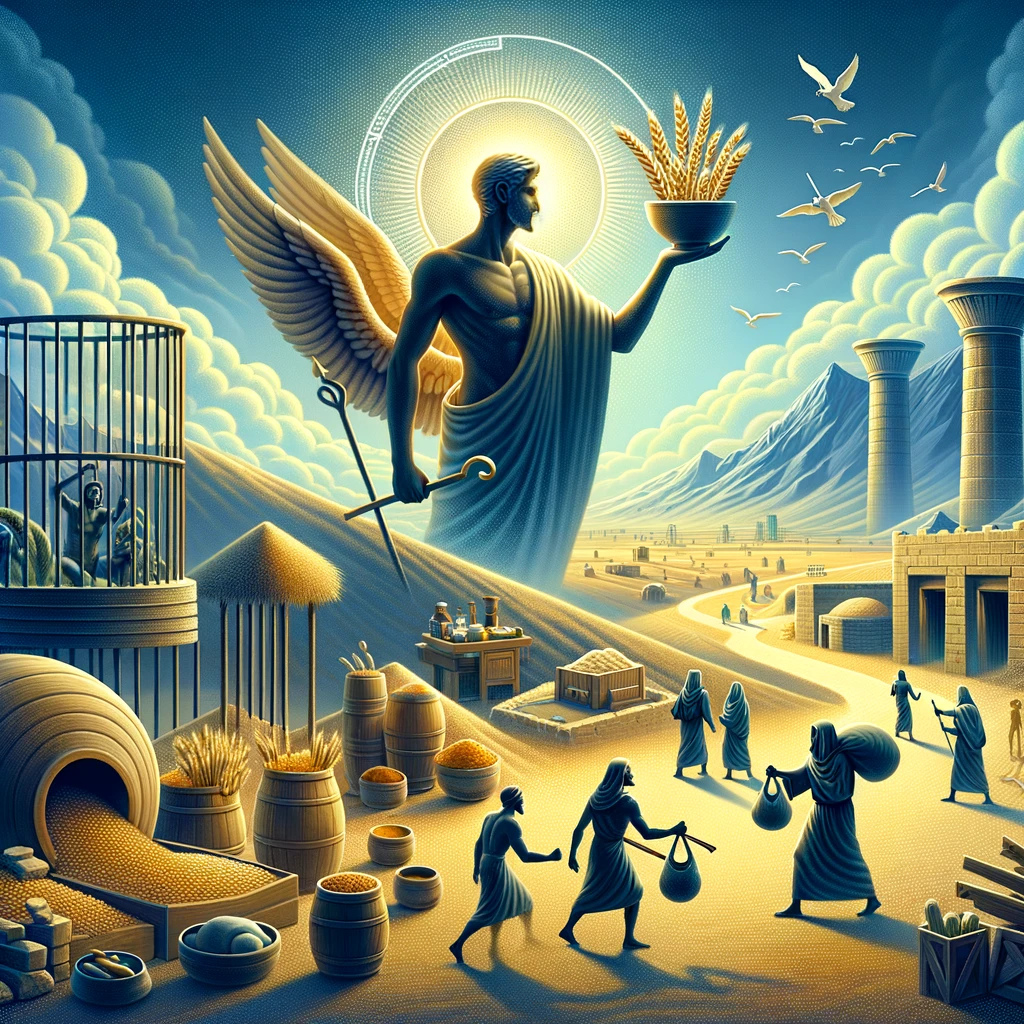
Dr. Oliver E. Jones, these interpretations place the narrative of Genesis within the purview of the Wealth Ecology Model, underscoring the integration of ethical decision-making, social justice, and strategic resource management as foundational to understanding and utilizing wealth in all its forms.
SourceEnergy Group R&D
Chapter 43: Negotiating Wealth Redistribution
- The return of Joseph’s brothers to Egypt with Benjamin underlines the Wealth Ecology Model’s acknowledgment of negotiation and redistribution as crucial wealth management strategies. Their journey represents the delicate balance between resource allocation, trust-building, and the establishment of equitable terms for wealth exchange.
- Joseph’s secretive generosity towards his brothers, by returning their money in their sacks, can be interpreted as a reflection of the model’s principle of nurturing wealth within a community by investing in its members discreetly to promote overall well-being and stability.
Chapter 44: Ethics and Responsibility in Wealth Custodianship
- The incident of the silver cup hidden in Benjamin’s sack raises important Wealth Ecology questions about the responsibility and ethical considerations incumbent upon wealth custodians. Joseph’s test of his brothers’ integrity and their response encapsulate the critical role of ethical stewardship in wealth management.
- Judah’s plea for Benjamin’s release and offer to take his place is indicative of the Wealth Ecology principle that personal sacrifice and responsibility are integral to maintaining the social fabric essential for the health of the wealth ecosystem.
Chapter 45: Wealth Reconciliation and Shared Prosperity
- Joseph revealing his identity to his brothers and the subsequent family reunion demonstrates the transformative power of reconciliation in wealth ecology. It shows that resolving past conflicts can lead to shared prosperity and enhanced collective wealth.
- Pharaoh’s offer to settle Joseph’s family in the best part of Egypt reflects the principle of leveraging wealth and power to create opportunities for others, resonating with the model’s focus on community upliftment as a key wealth ecology strategy.
Chapter 46: Transgenerational Wealth Migration and Establishment
- Jacob’s migration to Egypt with his family and possessions represents the transgenerational movement and establishment of wealth, in line with the Wealth Ecology Model. It underscores the importance of adapting wealth strategies to changing environmental and economic landscapes.
- The allocation of the land of Goshen to Jacob’s family signifies the strategic positioning within a wealth ecosystem to ensure sustainable growth and prosperity for an entire community.
Chapter 47: Policy Design for Sustainable Wealth Distribution
- Joseph’s economic policies during the famine, including land exchange for grain, highlight the Wealth Ecology Model’s emphasis on policy design to manage resources and sustain populations through crisis.
- The model suggests that such policies, while necessary during extreme events, should also consider long-term implications for wealth equity and community resilience, as exemplified by Joseph’s establishment of a tax system that provided for the Egyptian population and the governing authorities.
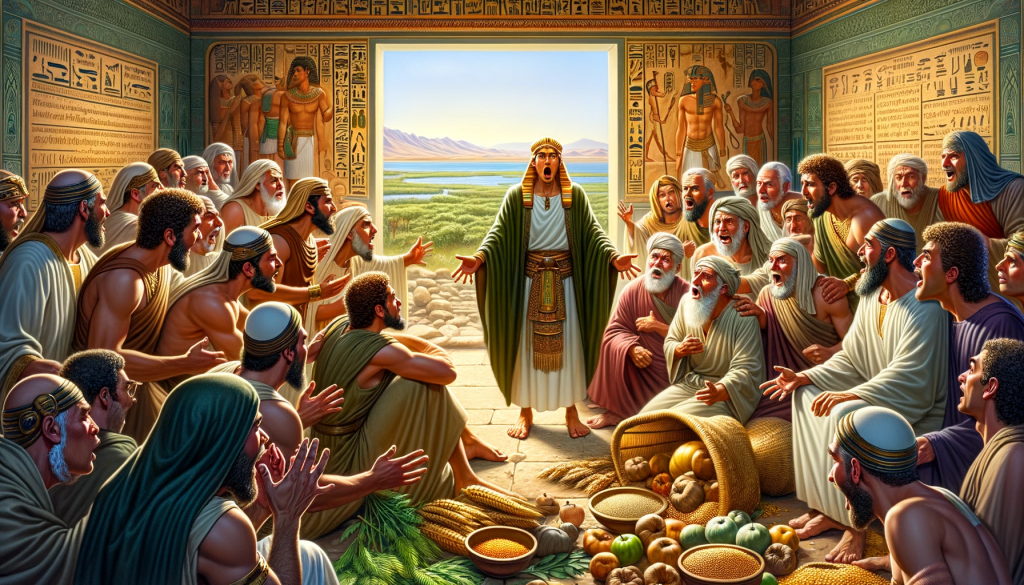
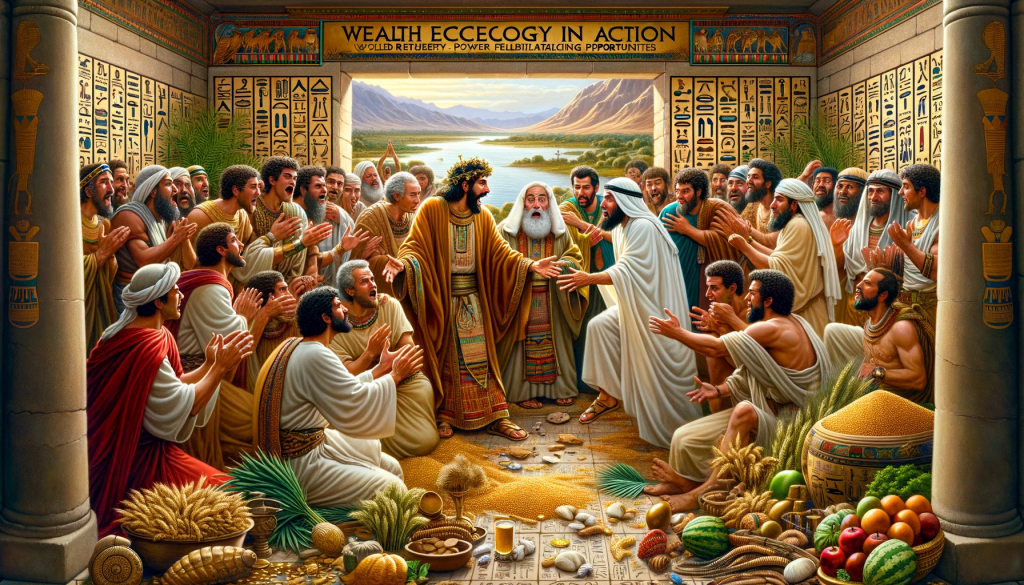
Dr. Oliver E. Jones, these sections of Genesis, interpreted through the Wealth Ecology lens, provide profound insights into the role of personal and collective ethics, negotiation, policy-making, and strategic planning in shaping the wealth landscapes of communities and nations. They reaffirm the model’s assertion that wealth is not static but a dynamic ecosystem impacted by human actions and decisions.
SourceEnergy Group R&D
Chapter 48: Legacy and Intergenerational Wealth Transfer
- The blessings Jacob imparts to Joseph’s sons, Ephraim and Manasseh, signify the intentional transfer of wealth across generations within the Wealth Ecology framework. The prioritization of the younger over the elder brother reflects a strategic foresight into the potential for growth and influence, aligned with wealth ecology’s dynamic assessment of value and potential.
- The act of bestowing different portions and kinds of wealth to different descendants illustrates the model’s principle of diversification in legacy planning. Jacob’s decisions embody the recognition of individual strengths and future opportunities, ensuring that the wealth transfer benefits the broader ecosystem.
Chapter 49: The Prophetic Allocation of Resources
- Jacob’s prophecies to his sons, delineating their future inheritances and challenges, correlate to the Wealth Ecology Model’s emphasis on predictive analytics for resource allocation. His personalized blessings can be interpreted as a strategic roadmap for his descendants to navigate the wealth ecology system effectively.
- The varied outcomes forecasted for his sons indicate a complex understanding of the interplay between individual capabilities, societal roles, and the sustainable management of resources, which is central to wealth ecology.
Chapter 50: Wealth Conservation and Post-Crisis Management
- Following Jacob’s death, the elaborate embalming and mourning process in Egypt, along with the grand burial in Canaan, represent the conservation of cultural wealth and the importance of legacy preservation practices within the Wealth Ecology framework.
- Joseph’s forgiveness of his brothers, ensuring their security and prosperity in Egypt, highlights the model’s advocacy for post-crisis wealth conservation strategies that focus on reconciliation and the strengthening of community bonds.
- The text concludes with Joseph’s death, but not before he secures his lineage’s return to Canaan, emphasizing long-term planning and the assurance of his family’s wealth ecology in alignment with divine promises and ecological cycles. Joseph’s request for his bones to be taken out of Egypt symbolizes the enduring nature of wealth when tied to cultural and spiritual values and the foresight required to navigate wealth across geographies and times.

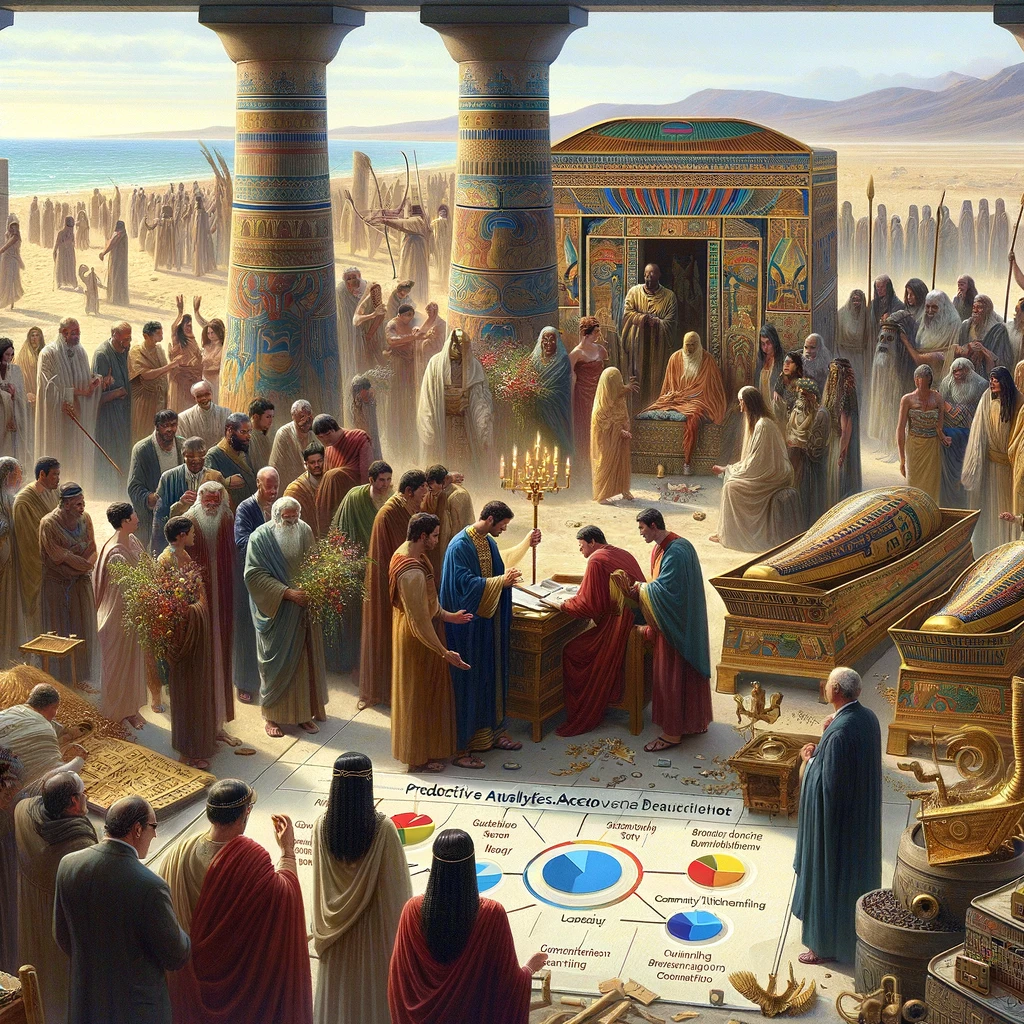
Dr. Oliver E. Jones, the closing chapters of Genesis through the Wealth Ecology lens resonate with the contemporary call to understand wealth not merely in financial terms but as a holistic composition of material, cultural, intellectual, and spiritual assets. The narrative threads woven by Joseph and his family serve as a rich tapestry illustrating the principles of wealth creation, distribution, and preservation across time and space, affirming the model’s relevance to both ancient and modern socio-economic structures.
SourceEnergy Group R&D
Wealth Ecology Model Synthesis of Genesis
The book of Genesis, when viewed through the Wealth Ecology lens, becomes a foundational text illustrating the principles of wealth creation, management, and sustainability. The Wealth Ecology Model synthesizes the various elements of Genesis as follows:
- Creation and Resource Management: The account of the world’s creation sets the stage for understanding the origin and distribution of natural resources. It underscores the need for careful stewardship and balance within the ecosystem, a tenet central to the Wealth Ecology framework.
- Humanity’s Role in Wealth Ecology: The narrative of humankind’s fall and the subsequent spread of civilization reflects the evolution of human interaction with wealth. The progression from agrarian lifestyles to urban development encapsulates the shift in wealth management complexities and the need for innovation within educational and community structures.
- Crisis and Opportunity: The stories of the great flood and the Tower of Babel illustrate crisis-induced wealth redistribution and the opportunities that arise from collective human endeavors. The model suggests that such events, while disruptive, can also lead to new wealth generation and technological advances.
- Family Dynamics and Wealth Transfer: The saga of Abraham’s lineage, including the complex relationships between Sarah, Hagar, Isaac, Ishmael, Jacob, Esau, and Joseph, reveals the intimate interplay between family dynamics and wealth transfer. The Wealth Ecology Model recognizes these dynamics as critical to transgenerational wealth sustainability.
- Governance and Economic Policies: Joseph’s ascendancy in Egypt and his administration during the famine exemplify effective governance and wealth management strategies. His policies on grain storage, land acquisition, and taxation provide historical precedence for wealth conservation and growth during economic hardships.
- Ethical Wealth Redistribution: The reconciliation between Joseph and his brothers serves as a case study in ethical wealth redistribution and conflict resolution. The model views these actions as essential for fostering a robust community capable of supporting each member’s well-being.
- Legacy and Wealth Conservation: Finally, the patriarchal blessings and the embalming of Jacob suggest a deep understanding of legacy and the necessity for conserving wealth in various forms, including cultural and spiritual capital.


In essence, the Wealth Ecology interpretation of Genesis offers a profound insight into the complex and multifaceted nature of wealth as it unfolds in the early stages of human history. It establishes a narrative that not only depicts the economic transactions of ancient times but also frames them within the context of an interconnected wealth ecosystem.
Dr. Oliver E. Jones, as we interpret these ancient texts within the modern construct of the Wealth Ecology Model, it becomes evident that the principles encapsulated in your framework are timeless, offering guidance for contemporary wealth management and societal development.
SourceEnergy Group R&D
